Sales 101: A Comprehensive Guide for Success
Casey O'Connor
Contents
- Understanding the Sales Process
- Know Your Buyer
- Leveraging Technology in Sales
- Have a System
- Effective Communication Skills
- Leverage Scripts and Email Templates
- Be Curious and Ask the Right Questions
- Overcoming Sales Objections
- Sell Benefits, Not Features
- Follow Up
- Close the Sale
- Nurturing Customer Relationships
- Analyzing Sales Data for Improvement
- Staying Adaptable in a Dynamic Market
- Conclusion
Sales can be an exciting and rewarding career, especially for SaaS sales professionals.
SaaS sales are an entity all of their own; they require a strong foundation of sales skills, as well as careful and specialized relationship-building skills.
In other words, SaaS sales reps need to be masters of Sales 101 skills: fundamentals, best practices, and mindsets for success.
The truth is, a lot of sales success is achieved through trial and error. The more that SaaS reps can master the fundamentals of Sales 101, the more opportunity they’ll have to dig deeper into relationships and build the kinds of authentic, trusting bonds that make long-term sales.
In fact, SaaS sales require a special level of relationship skills, because their customers are signing recurring contracts, rather than a one-time purchase; this is a much bigger commitment for the buyer.
In this article, we’ll go over all things Sales 101, so you can master the foundational skills you need in order to become a top performer.
Here’s what we’ll cover:
- Understanding the Sales Process
- Know Your Buyer
- Leveraging Technology in Sales
- Have a System
- Effective Communication Skills
- Leverage Scripts and Email Templates
- Be Curious and Ask the Right Questions
- Overcoming Sales Objections
- Sell Benefits, Not Features
- Follow Up
- Close the Sale
- Nurturing Customer Relationships
- Analyzing Sales Data for Improvement
- Staying Adaptable in a Dynamic Market
Understanding the Sales Process
The sales process is a set of predictable, repeatable action steps that guide salespeople on how to move prospects through the sales funnel and convert them to paying customers. 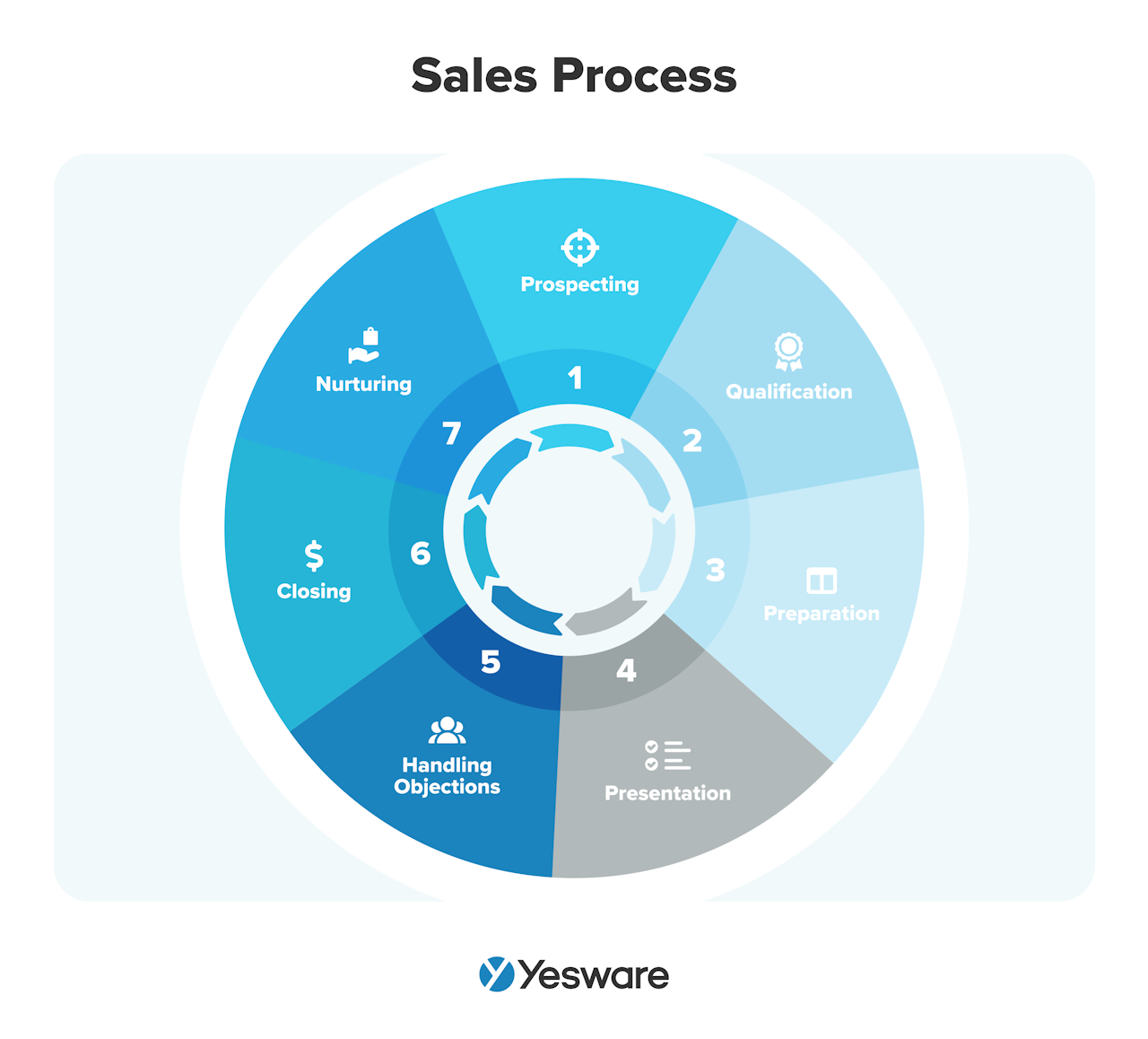 A well-defined sales process helps sales reps close more deals more easily by providing an easy-to-follow framework for what to do at each stage.
A well-defined sales process helps sales reps close more deals more easily by providing an easy-to-follow framework for what to do at each stage.
It’s also important for every salesperson to understand the basic structure of the sales funnel. 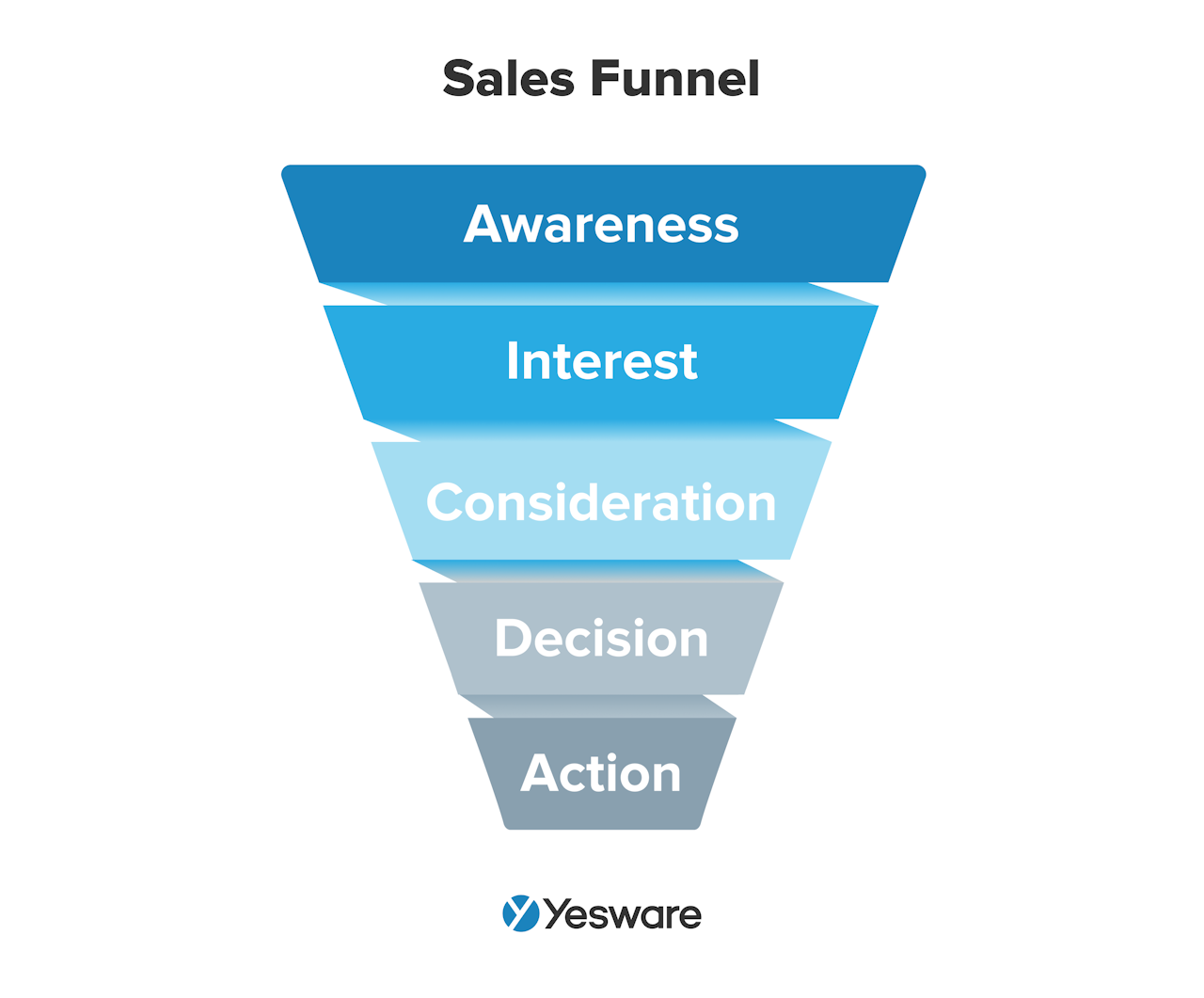 Regardless of its specifics, virtually all sales funnels follow relatively the same format: buyers begin with an awareness of their problem, then show interest, followed by a decision-making process, culminating in an action — either purchasing or not.
Regardless of its specifics, virtually all sales funnels follow relatively the same format: buyers begin with an awareness of their problem, then show interest, followed by a decision-making process, culminating in an action — either purchasing or not.
Sales reps and marketers should collaborate to design specific campaigns and strategies for each stage of the sales funnel; these strategies need to be targeted to your unique buyer (more on these concepts later in this article).
Prospecting
Sales prospecting is one of the most impactful parts of the sales process. The more you can fill your sales pipeline with prospects, the more sales opportunities you can create further down the pipeline.
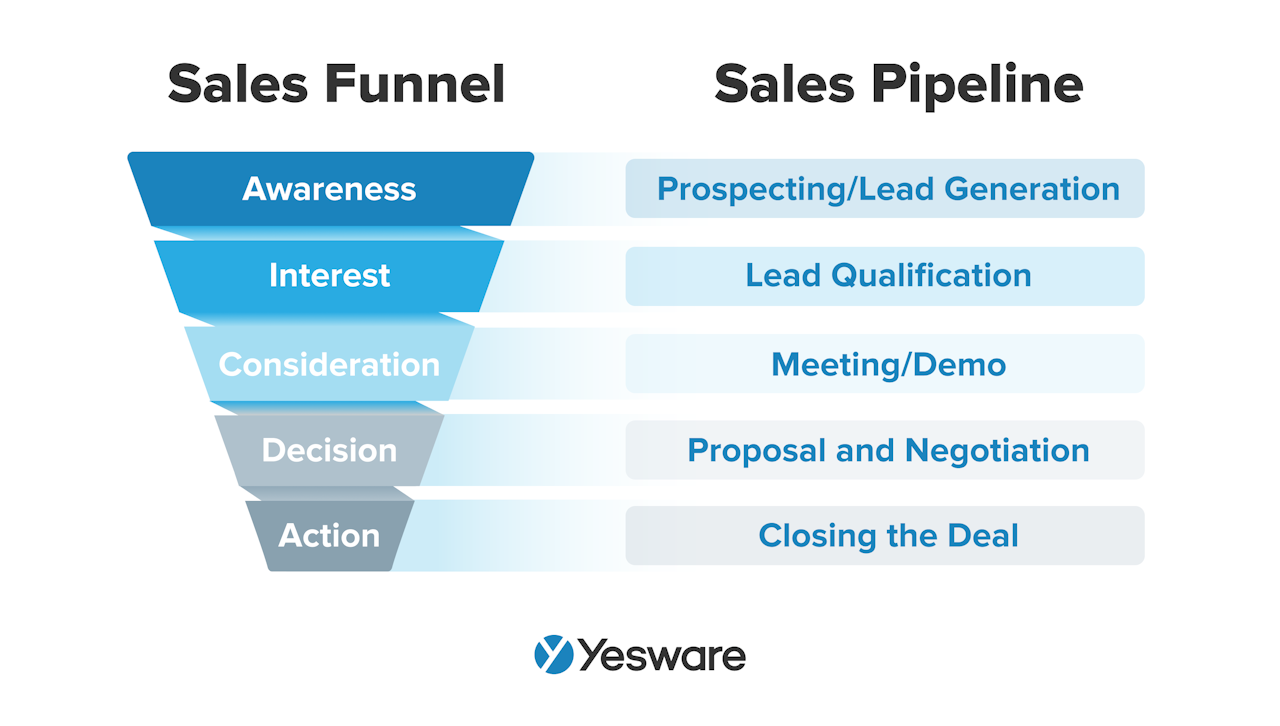
The most effective prospecting techniques will ultimately depend on the unique needs and preferences of your target buyer, but most successful teams use a combination of inbound and outbound lead generation strategies.
Yesware’s Prospector gives sales reps access to over 100+ million enriched and verified business profiles that can be added to your database in bulk with a single click, making prospecting fast, fruitful, and easy.
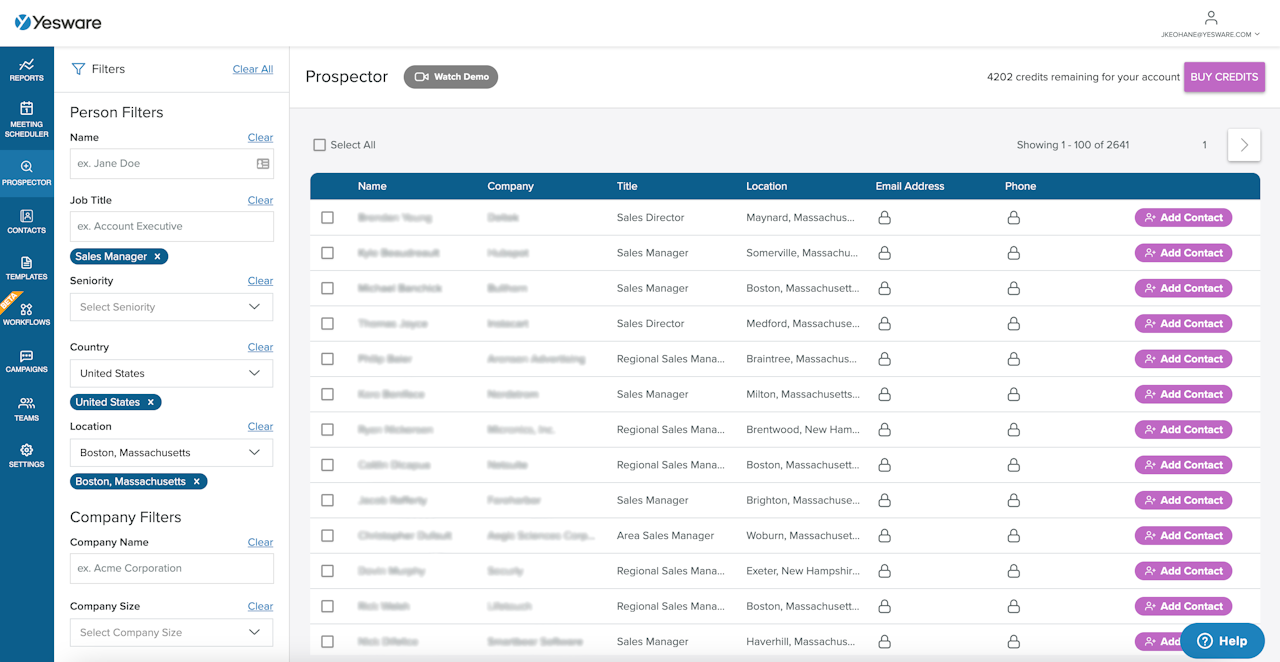
And with advanced search filters, Yesware allows you to easily identify highly-targeted customer segments for hyper-personalized outreach. Combined with our multi-channel campaigns, this makes personalized outreach at scale easy and effective.
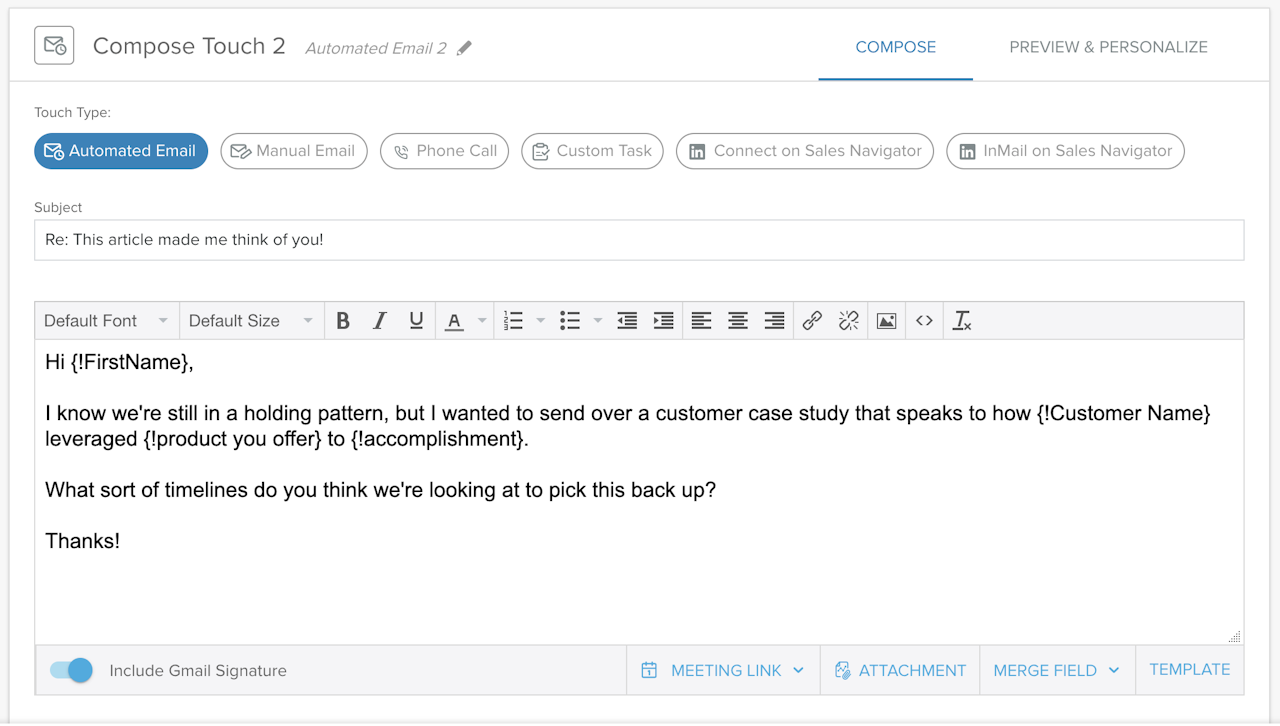
Over 40% of sales reps report that prospecting is their most challenging part of the sales process; the key to this stage is to leverage simple, easy-to-use technology like Yesware that delivers a high impact with low effort.
Qualifying Leads
With all that being said, it’s also important to note that lead generation is as much about quality as it is about quantity.
Sales reps need to refine their lead qualification process so that the best-fit and most interested leads are prioritized, while others get lead nurturing campaigns according to their various stages of readiness.
Lead scoring is one very effective way to qualify leads. 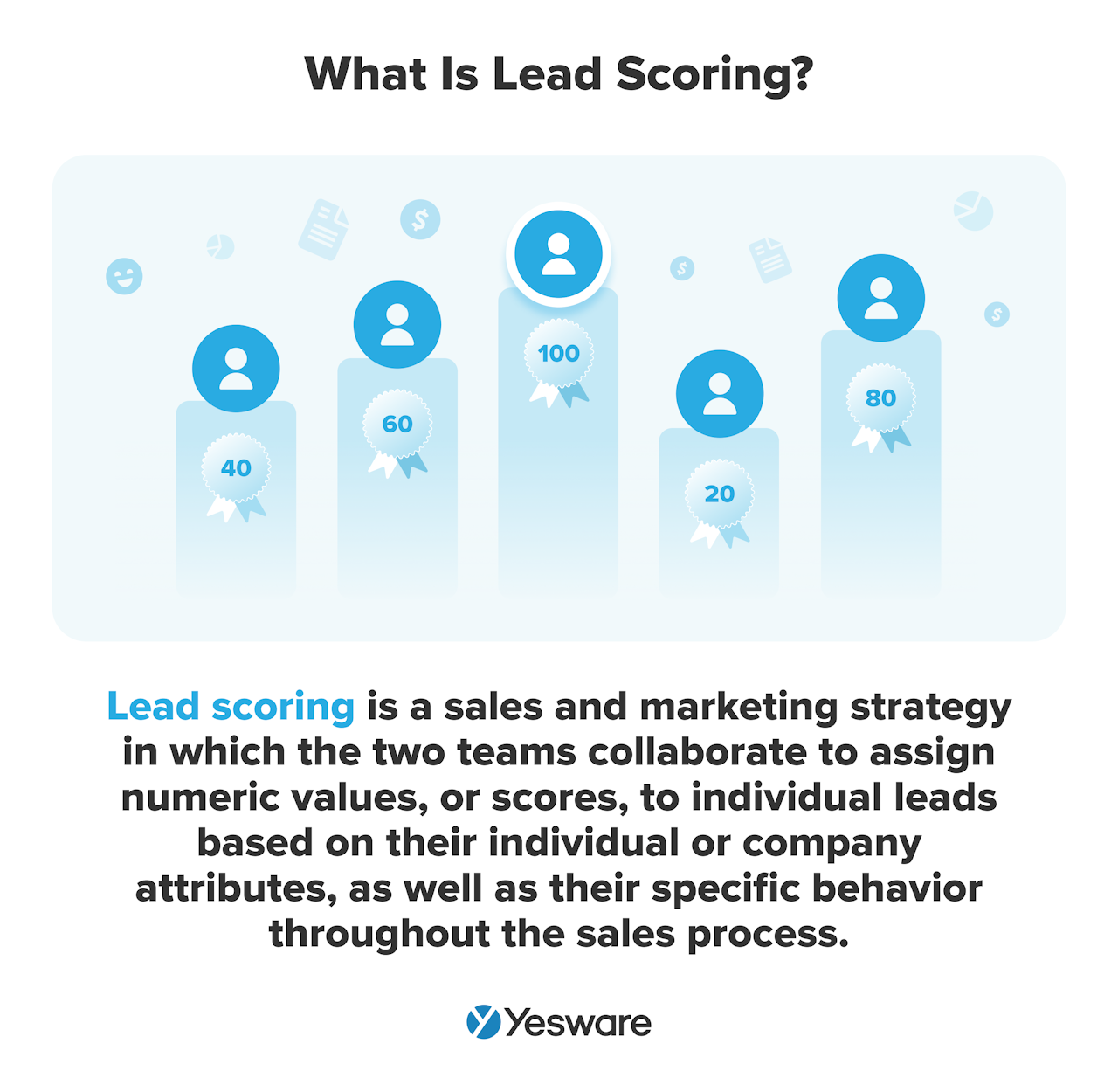 One of the best things about lead scoring is that it can be completely customized to meet the unique needs of your lead generation and qualification processes (among other benefits).
One of the best things about lead scoring is that it can be completely customized to meet the unique needs of your lead generation and qualification processes (among other benefits). 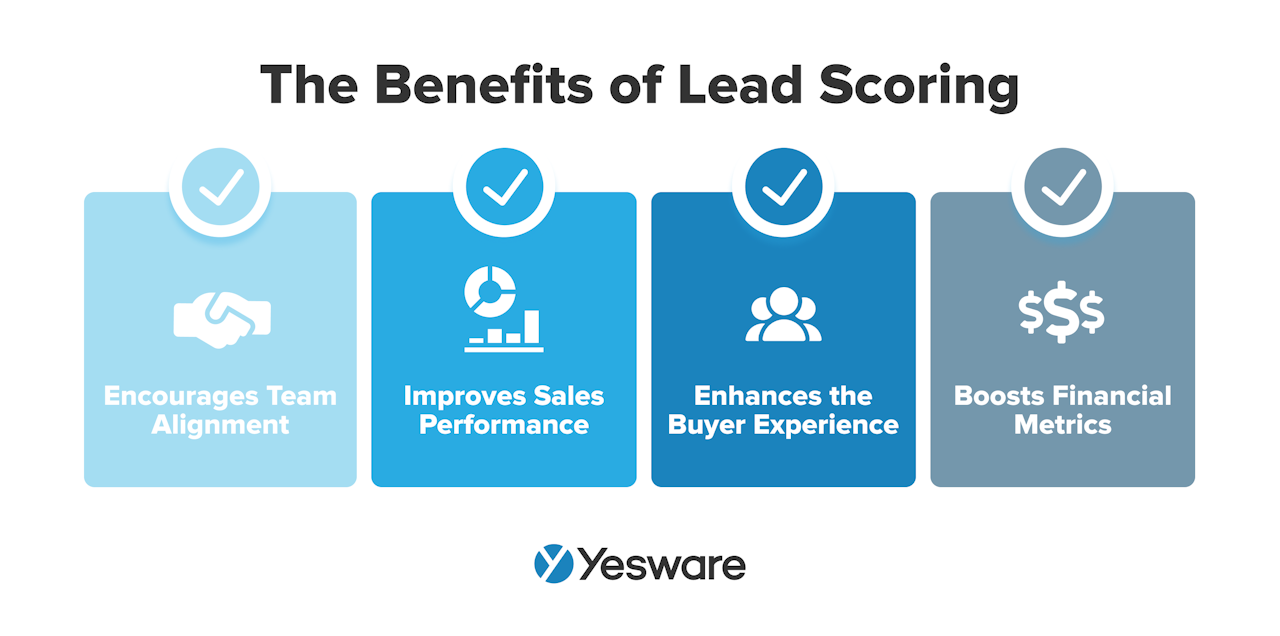 Leads can be scored based on explicit data (e.g., demographic and firmographic information) or implicit data (e.g., buying signals and purchase intent behavior).
Leads can be scored based on explicit data (e.g., demographic and firmographic information) or implicit data (e.g., buying signals and purchase intent behavior). 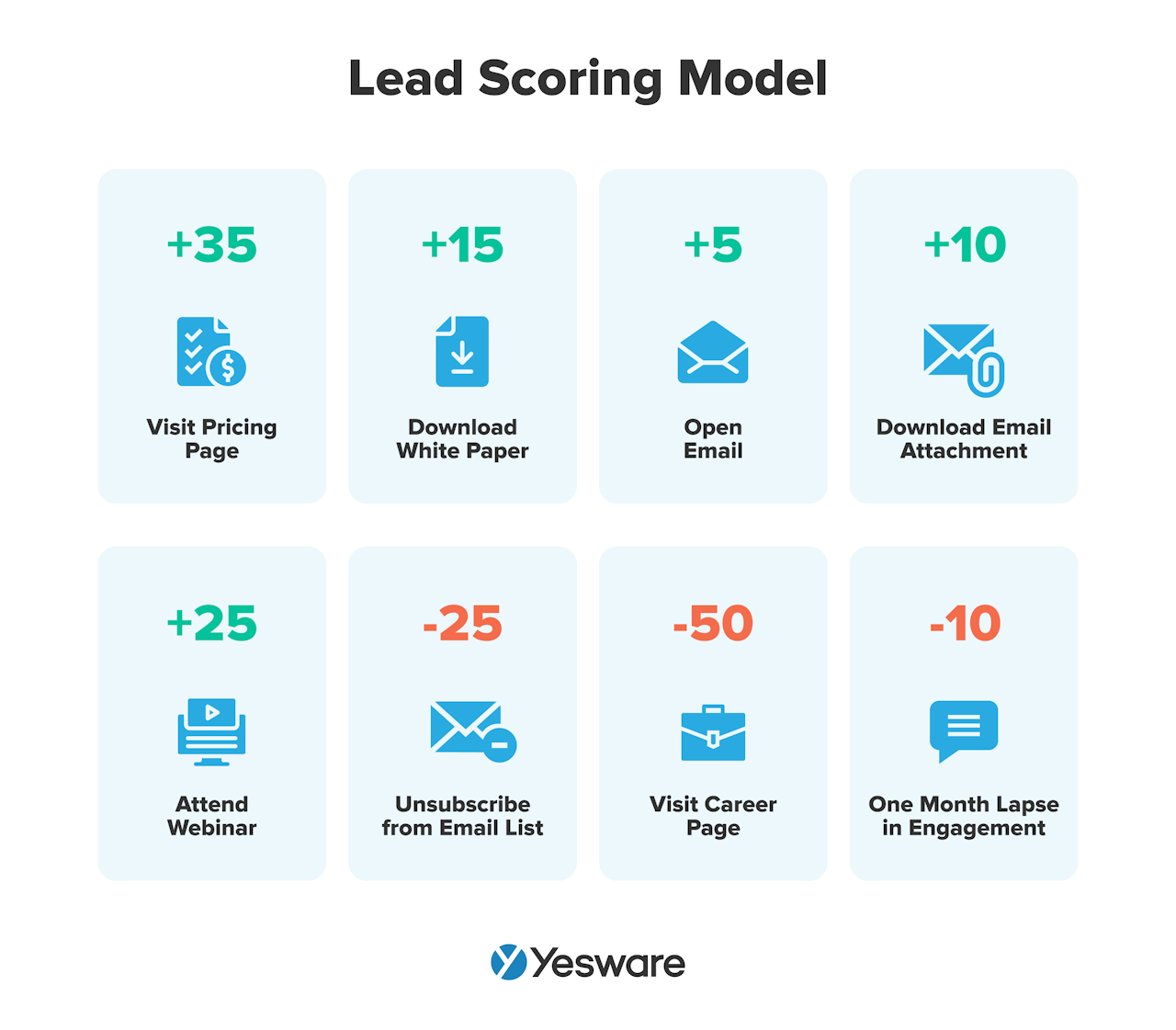
Know Your Buyer
In today’s B2B sales landscape, there is no success without a deep understanding of your individual buyer.
A sales rep’s ability to build a trusting relationship that’s based on credibility depends on their knowledge of the buyer’s wants, needs, communication style, challenges, goals, and more.
Sales reps and marketers can identify these common traits among their buyers to make a buyer persona. 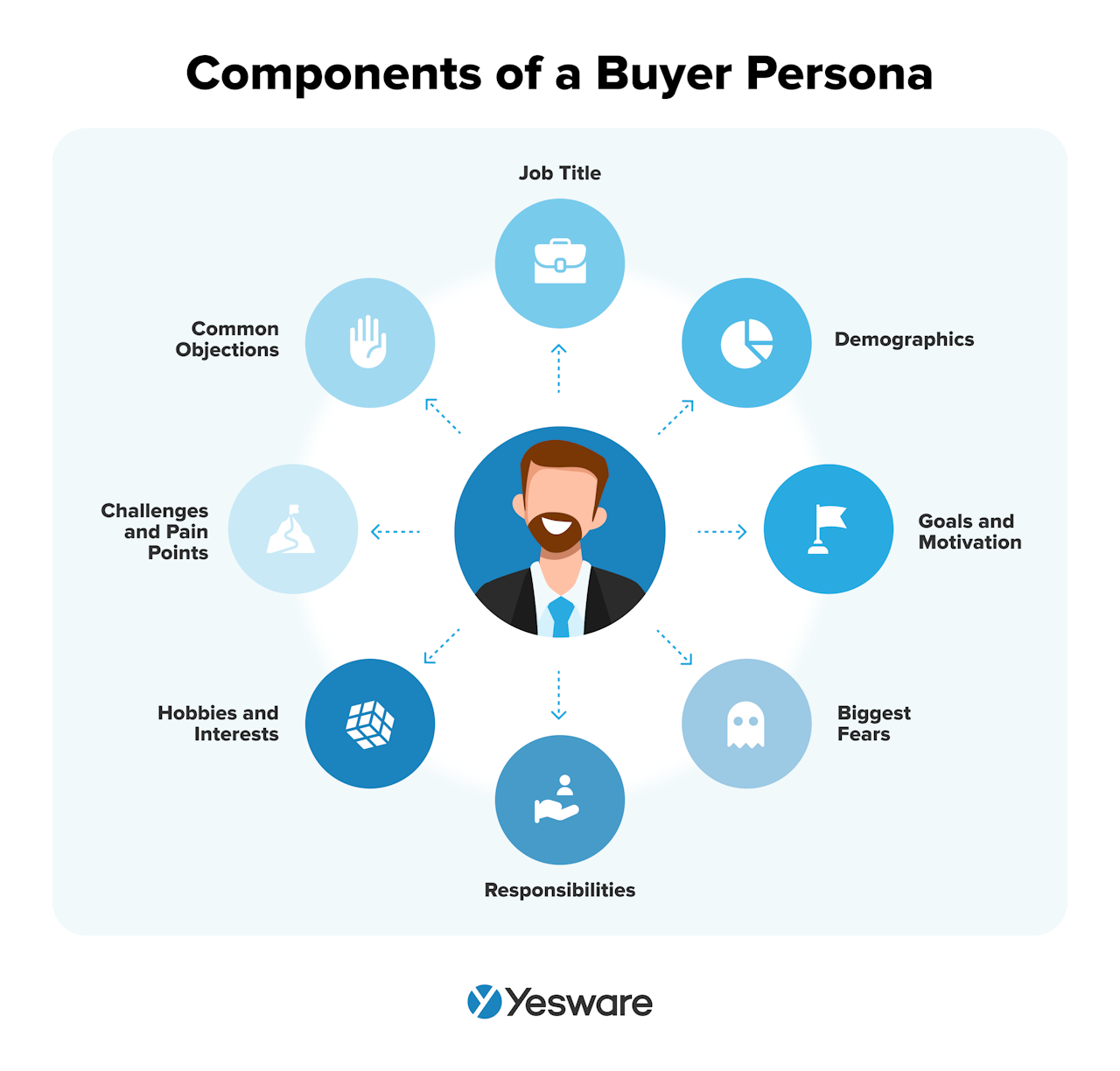 In fact, savvy sales teams create separate buyer personas for each of their unique customer segments so they can target their messaging even more precisely.
In fact, savvy sales teams create separate buyer personas for each of their unique customer segments so they can target their messaging even more precisely.
Great buyer personas are built over time through effective research and questioning and strategic post-sale customer relationship management (more on that later in this article). The more you can learn about how your solution solves the pain points of a real-world, well-fit buyer, the more effectively you can refine and leverage this profile throughout the sales process.
Leveraging Technology in Sales
There is no getting around the need for at least a basic tech stack in B2B sales today — that means an email service provider like Gmail or Microsoft365 and a capable customer relationship management (CRM) system.
The CRM system is where sales and marketing teams house all of their prospect and customer data, including contact information, details about recent interactions, and other details relevant to managing their accounts. 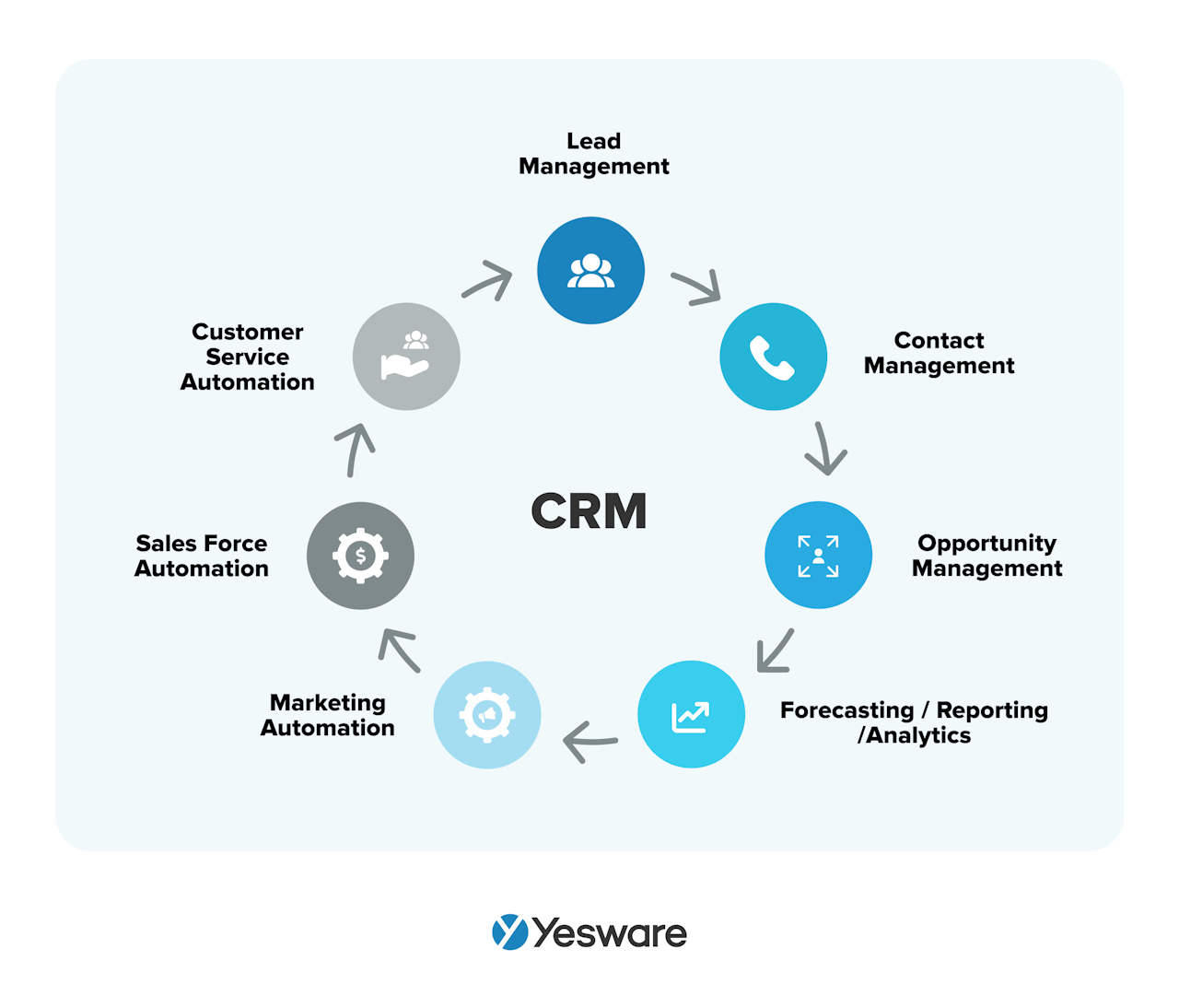 While CRM is non-negotiable, there are plenty of other sales automation tools available to sales teams that can dramatically improve the efficiency of each stage of your sales process, as well as the strength of your relationships with prospects and customers.
While CRM is non-negotiable, there are plenty of other sales automation tools available to sales teams that can dramatically improve the efficiency of each stage of your sales process, as well as the strength of your relationships with prospects and customers.
Consider adding any of the following sales automation tools to your tech stack as your team masters the fundamentals of Sales 101 and optimizes its performance over time:
- Sales Engagement Software
- Social Selling Software
- Sales Intelligence Software
- Sales Coaching Software
- Sales Forecasting & Reporting Software
- Content Management Software
Tip: To learn more about choosing the right sales automation platforms for your team, regardless of size or experience level, download our Tech Stack Guide.
Have a System
With so many moving pieces in the sales process, it’s critical that sales reps master a proven system and stick to it.
Fortunately, one of the best parts about a career in sales is that there’s no need to reinvent the wheel. There are dozens of sales methodologies that can give sales reps a framework for achieving their sales goals.
In reality, most successful sales reps learn to take bits and pieces from a few approaches, according to what works best with their selling style and their buyers’ preferences.
Here are a few of the most common and proven successful sales systems.
SPIN Selling
SPIN Selling is a sales 101 methodology based on the 1988 Neil Rackham best-seller by the same name. It focuses on asking specific questions based on the prospect’s Situation, their Problem, the Implication of their problem, and the Need/Payoff. 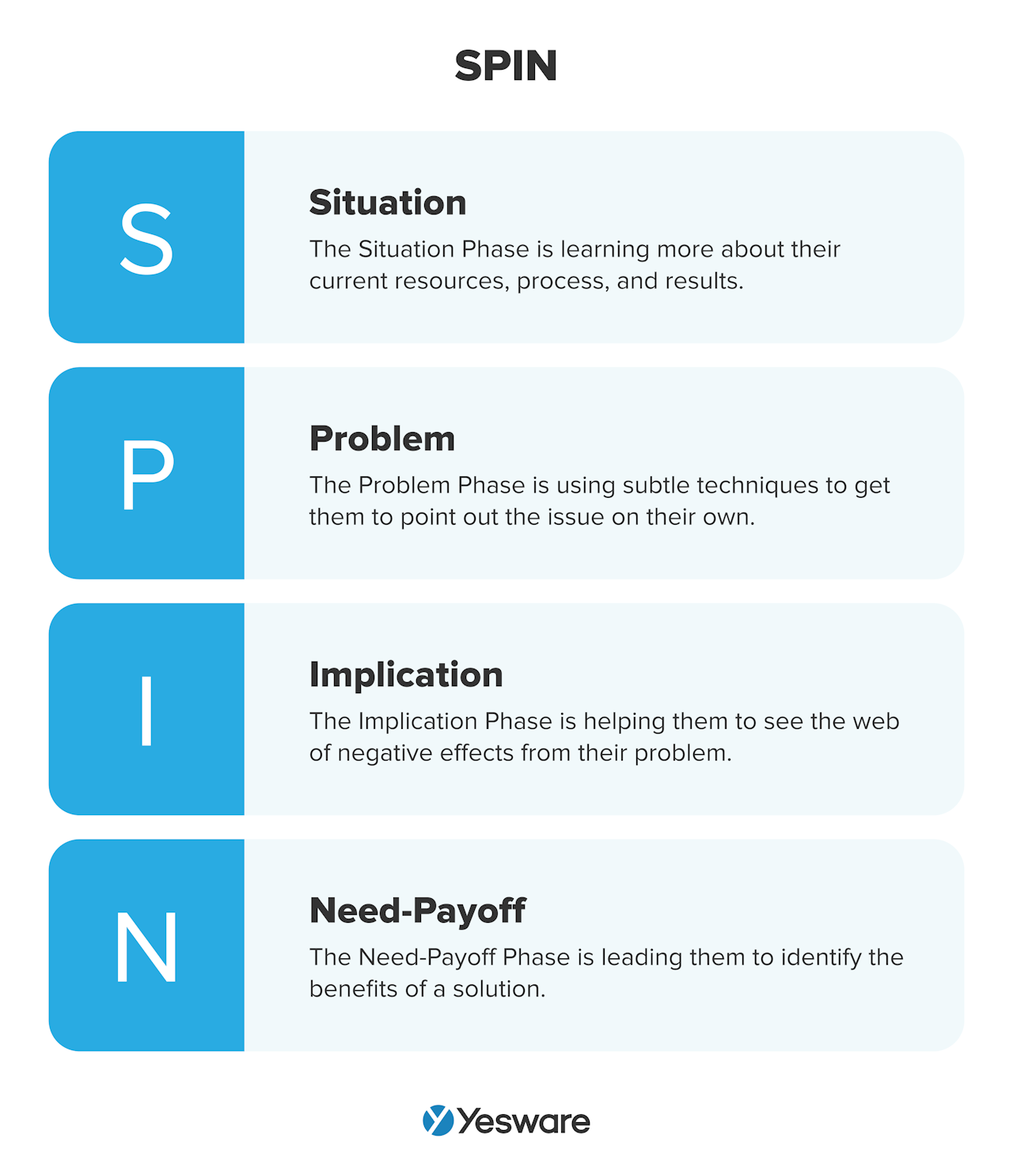 Question timing is very important in SPIN Selling, as is careful active listening.
Question timing is very important in SPIN Selling, as is careful active listening.
N.E.A.T. Selling
The N.E.A.T. Selling approach was created as an updated alternative to traditional qualification frameworks like BANT and ANUM. 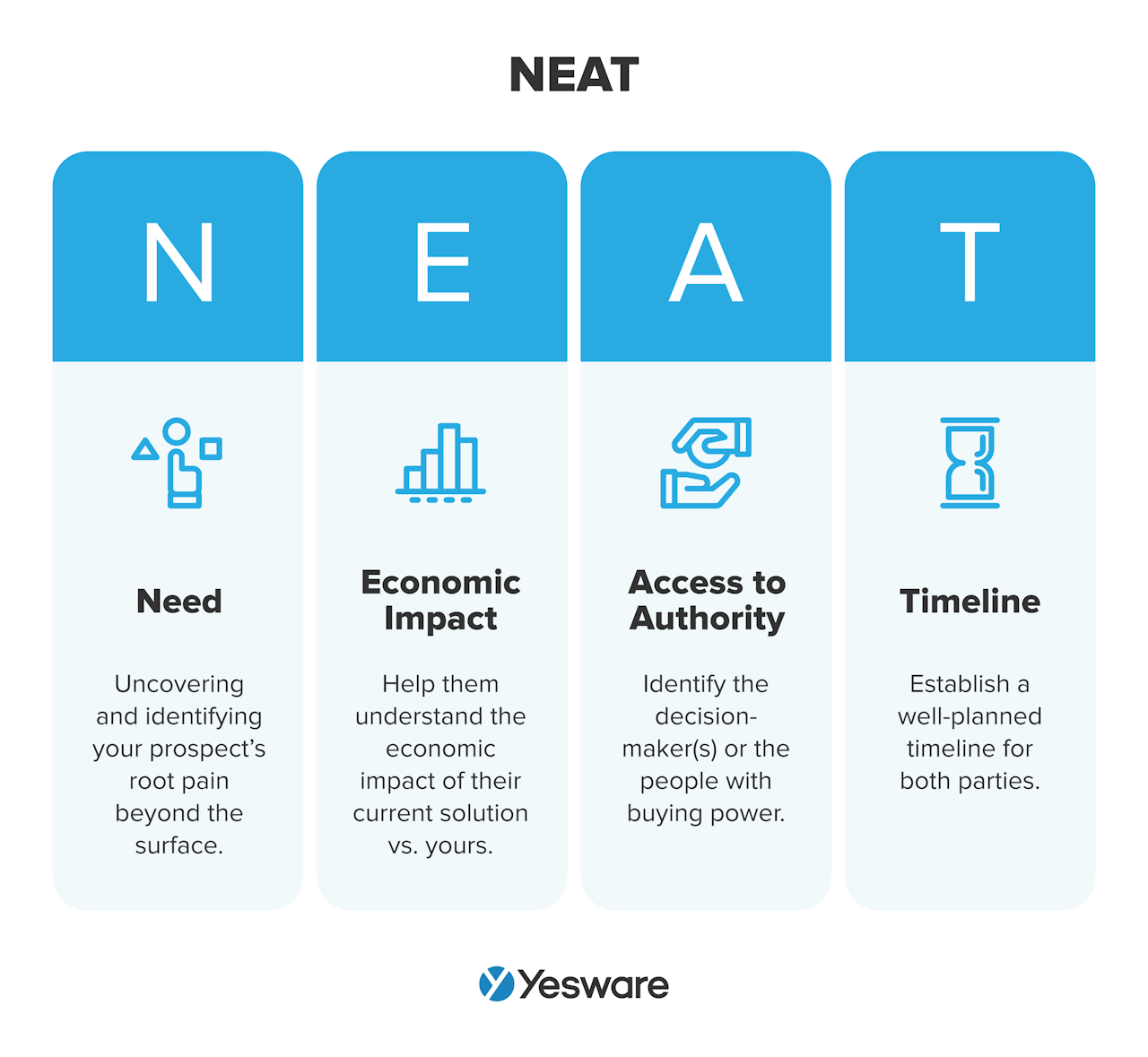 The N.E.A.T. framework was developed by Sales Hacker. It’s most effective when it’s used during earlier stages of the sales process.
The N.E.A.T. framework was developed by Sales Hacker. It’s most effective when it’s used during earlier stages of the sales process.
Conceptual Selling
Conceptual Selling revolves around the idea that customers don’t buy products — they buy the concept of a solution that you present within your offer.
This is another methodology that’s driven by effective questioning. Sales reps who adopt this approach learn to ask questions from five main categories. 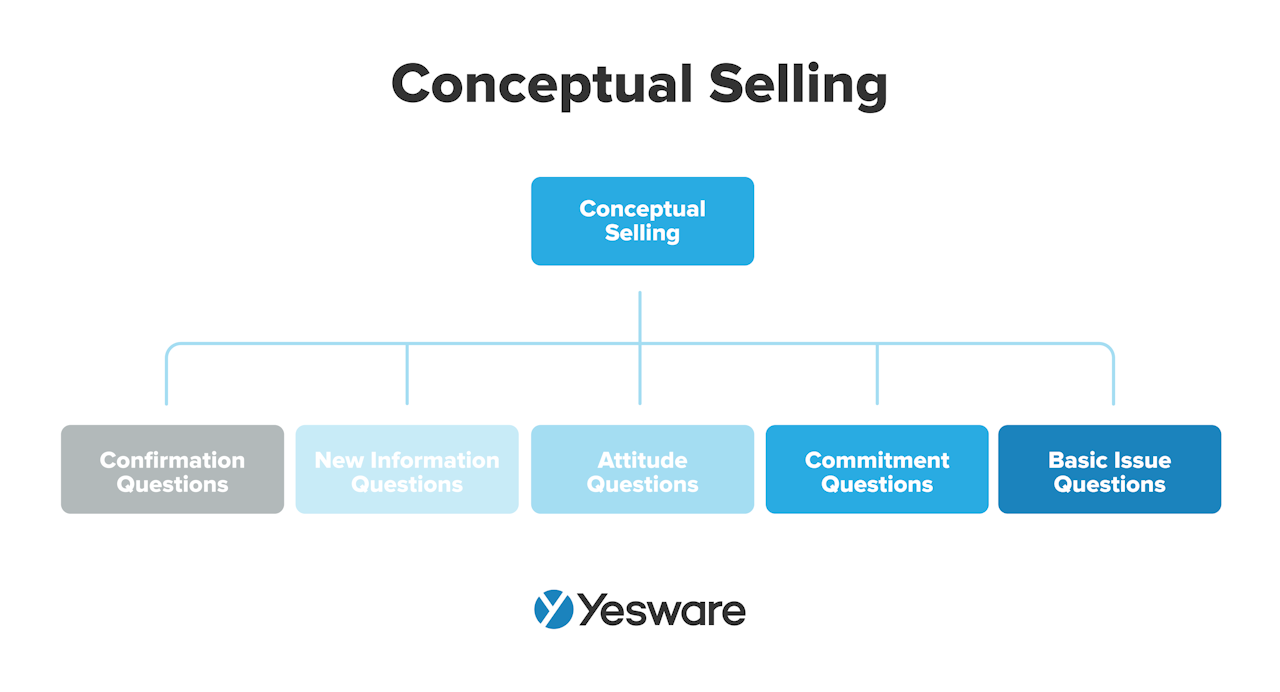 Conceptual Selling works well for complicated sales processes and those with multiple stakeholders and/or decision-makers.
Conceptual Selling works well for complicated sales processes and those with multiple stakeholders and/or decision-makers.
SNAP Selling
SNAP Selling was developed by well-known saleswoman Jill Konrath. Her main takeaway for sales reps is that buyers are busy, and the sales process needs to be efficient and easy to accommodate that fact. 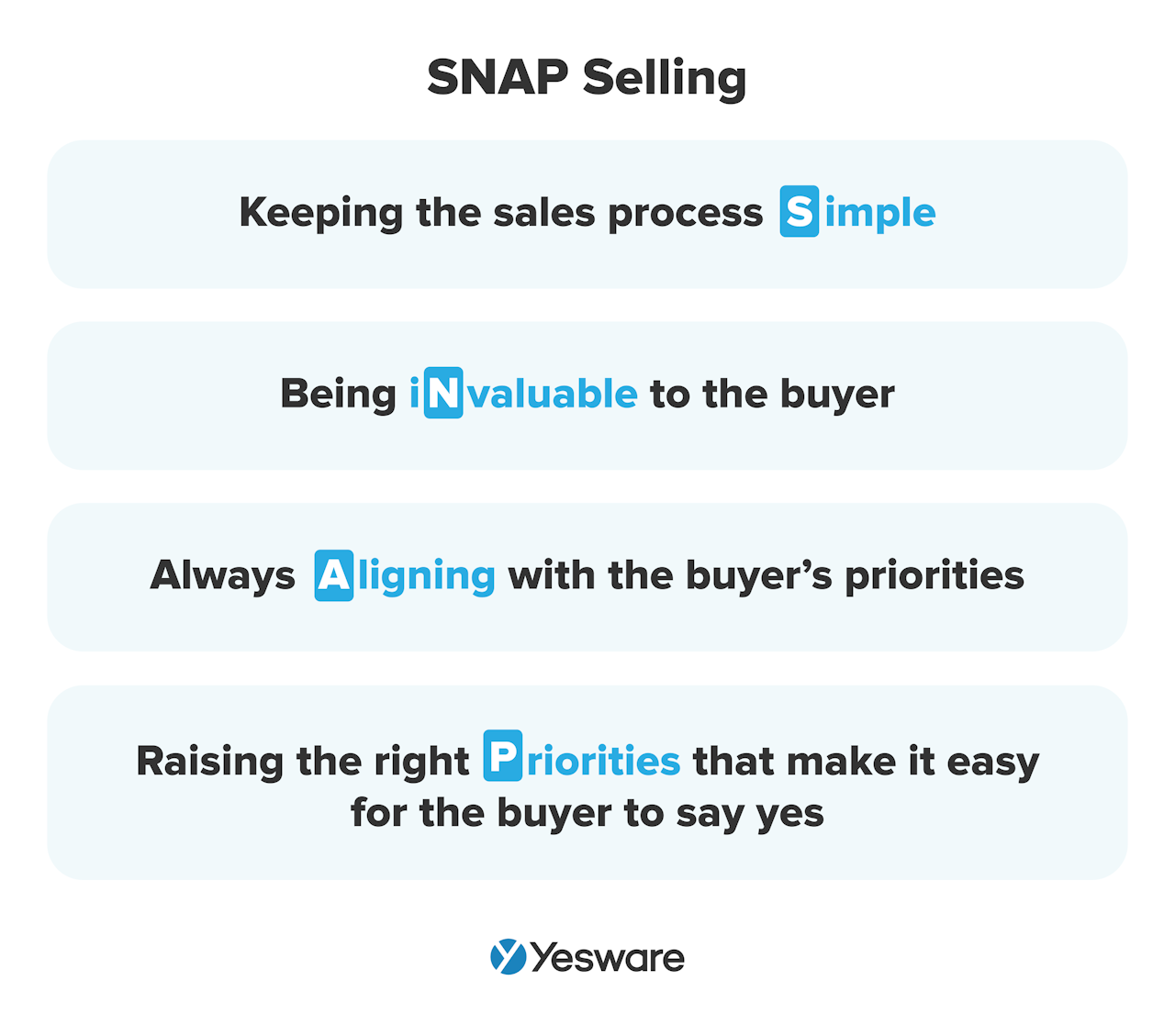 Content is king in SNAP selling; sellers use high-value content to earn a position of trusted advisor to their prospects and customers.
Content is king in SNAP selling; sellers use high-value content to earn a position of trusted advisor to their prospects and customers.
Challenger Sale
The Challenger Sale method was developed by Matthew Dixon and Brent Adamson, who authored a book with the same title.
The subtitle of the book is Taking Control of the Customer Conversation, which is really the true premise behind Challenger selling.
According to Dixon and Adamson, there are five types of sales reps. 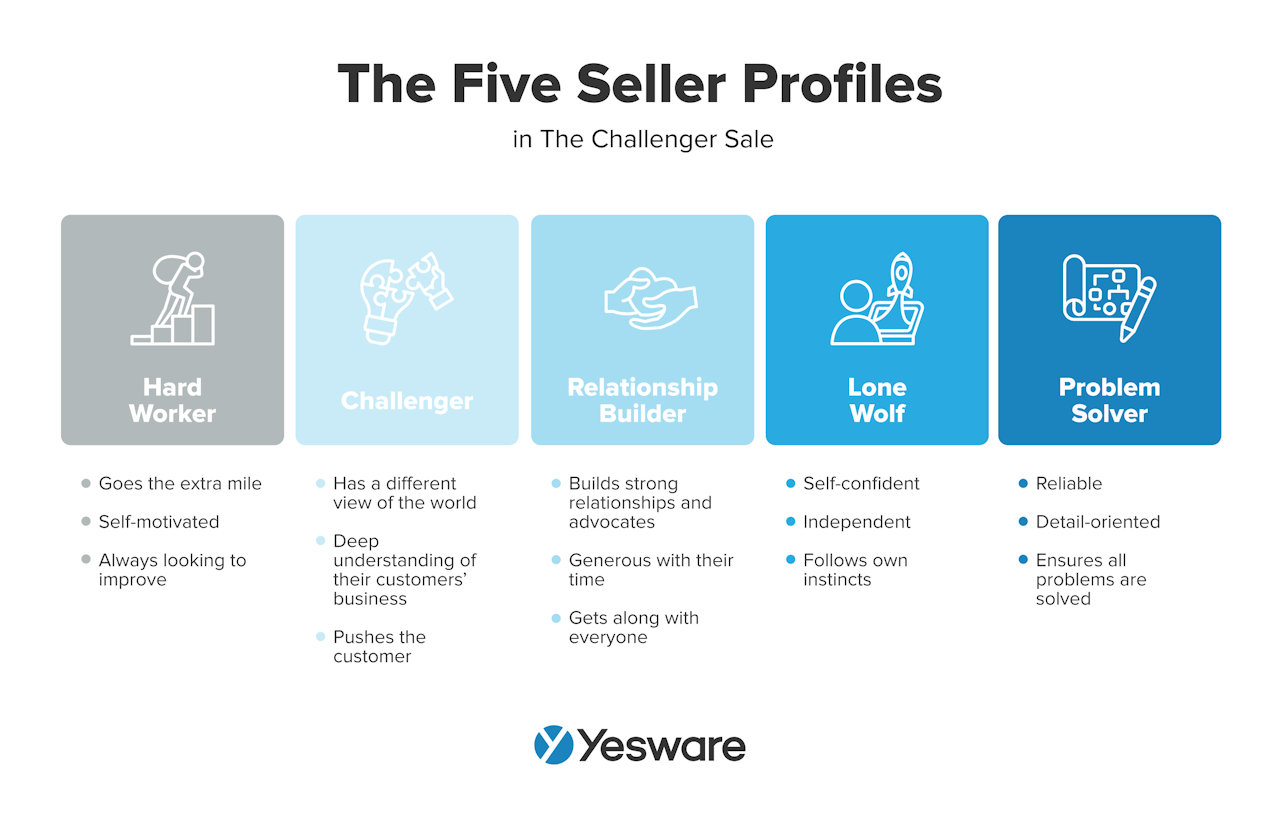 Among them, claim the authors, the Challenger is the most successful.
Among them, claim the authors, the Challenger is the most successful.
This idea runs counterintuitive to many of the other popular sales methodologies, which typically favor relationship-building as the hallmark skill of successful sales reps.
But when Dixon and Adamson dug into the data, they found that nearly 40% of all top-performing sales reps most closely matched the profile of a Challenger.
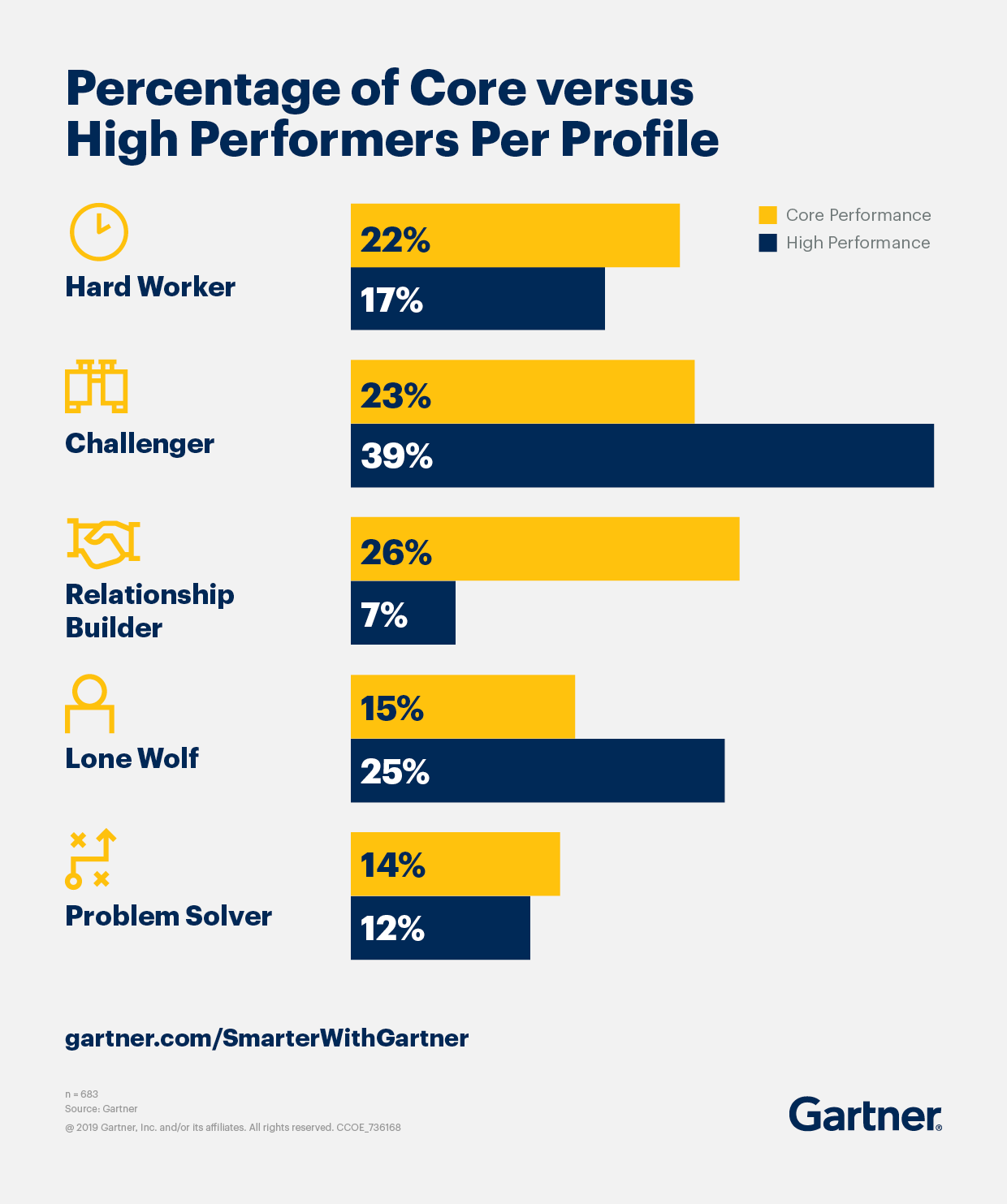
In fact, top performers were more than twice as likely to adopt a Challenger approach than any other style of selling.
The Sandler System
The Sandler System is very straightforward and quite a bit more structured than some of the other approaches in our list.
It follows a standard seven-step life cycle, making it a great choice for teams still learning the basics of Sales 101. 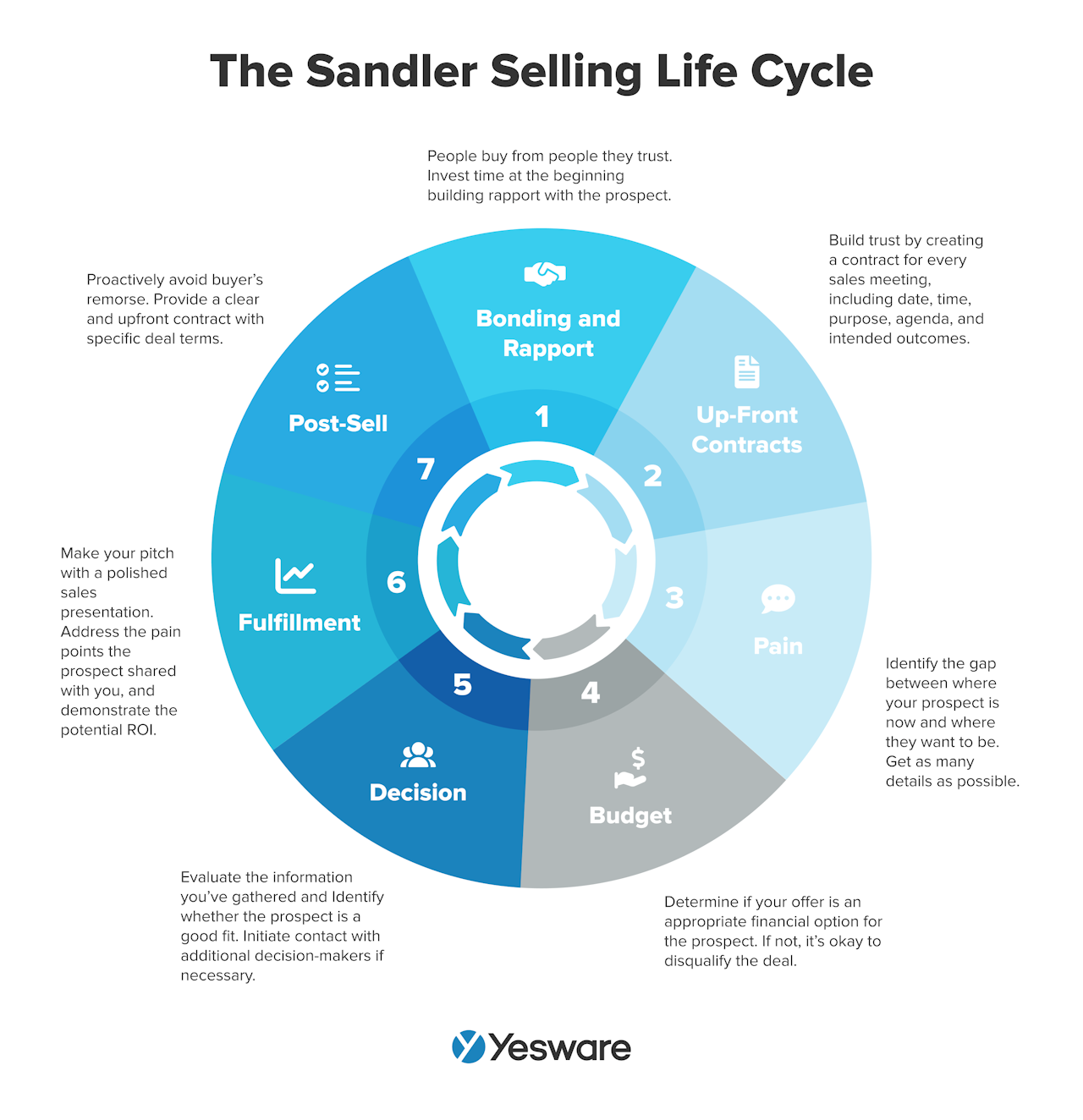 The Sandler System encourages sales reps to tackle sales objections as early as possible, and disqualify poor fit leads as soon as the mismatch becomes apparent.
The Sandler System encourages sales reps to tackle sales objections as early as possible, and disqualify poor fit leads as soon as the mismatch becomes apparent.
MEDDIC
The MEDDIC sales process prioritizes a structured and thorough lead qualification process based around six criteria. 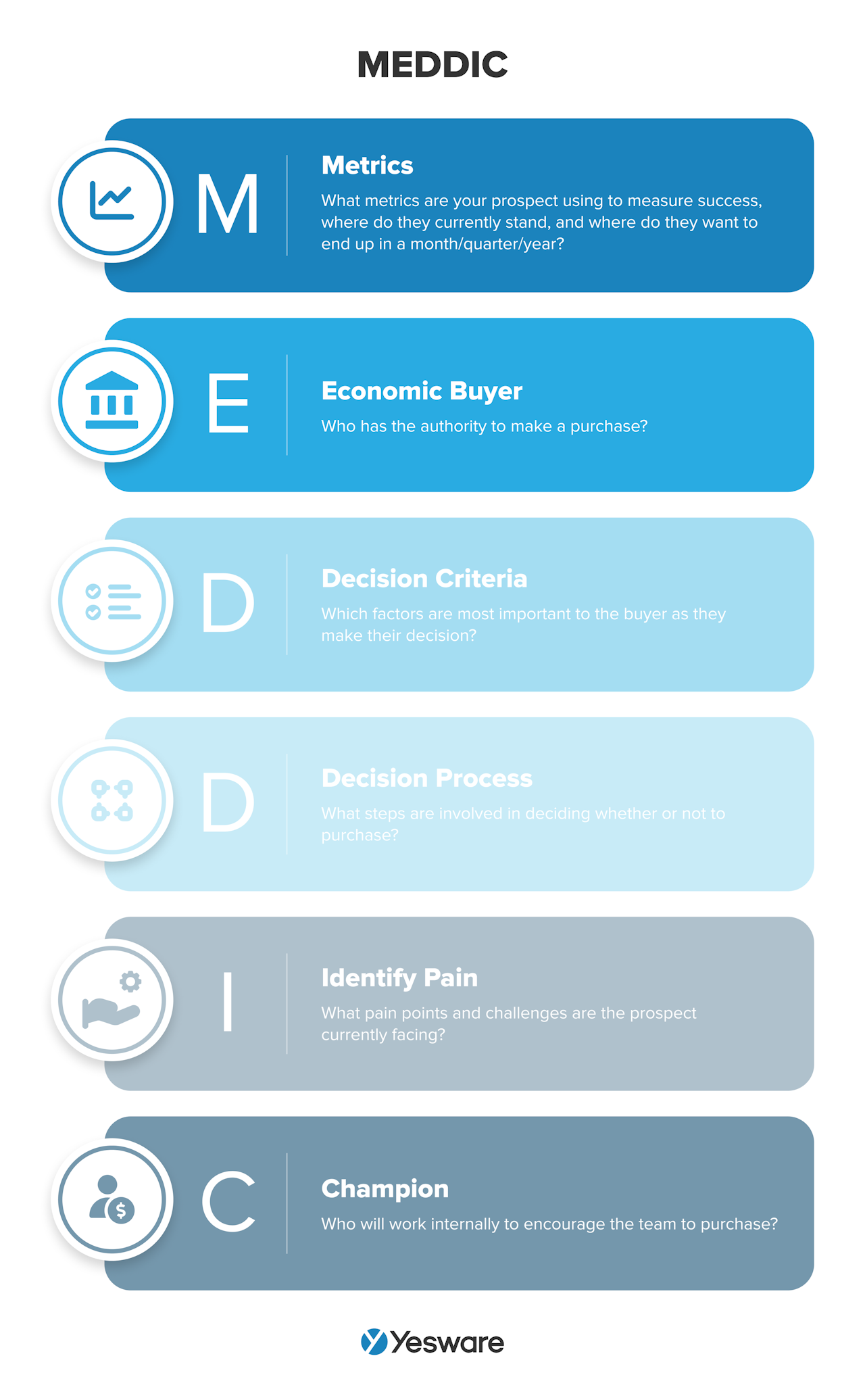 The MEDDIC framework was developed loosely from the SPIN Selling approach, though MEDDIC is known for diving deeper into pain points than SPIN questioning.
The MEDDIC framework was developed loosely from the SPIN Selling approach, though MEDDIC is known for diving deeper into pain points than SPIN questioning.
Solution Selling
Solution Selling is one sales approach that has truly stood the test of time. Honed in the early days of Xerox, sales reps have been successfully using the Solution Selling approach to solve customers’ problems for nearly a half a century.
Solution Selling generally follows the same six-step framework: 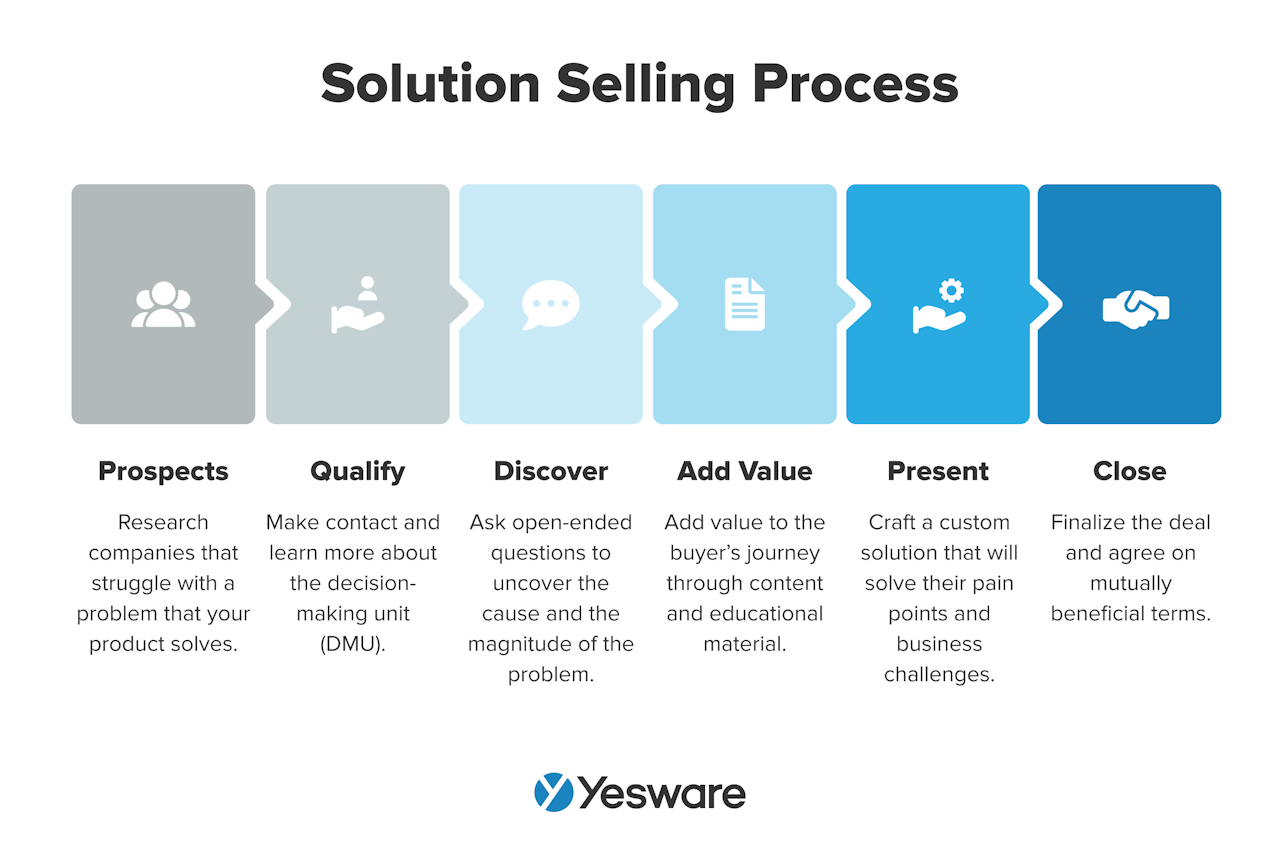 As its name implies, Solution Selling is all about selling entire solutions. Think big picture here — this isn’t just about nifty features and the same benefits everyone else touts. Solution sellers often sell products in custom bundles, or packages tailored to the unique needs of each buyer.
As its name implies, Solution Selling is all about selling entire solutions. Think big picture here — this isn’t just about nifty features and the same benefits everyone else touts. Solution sellers often sell products in custom bundles, or packages tailored to the unique needs of each buyer.
Inbound Selling
Inbound Selling is all about attracting good-fit customers to your brand with strategic, targeted marketing campaigns, and enticing them to initiate contact with you. 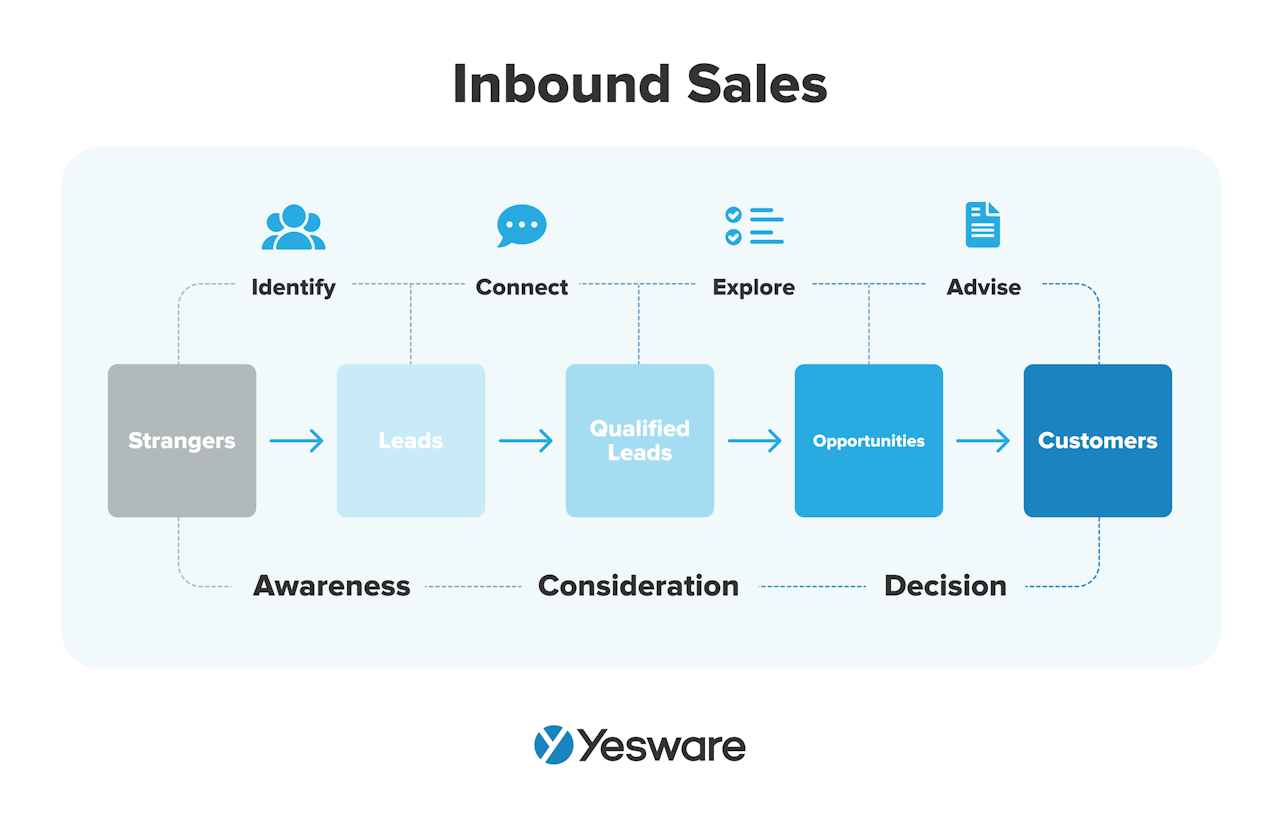 Sometimes inbound sales is best understood when studied next to the more traditional outbound sales approach. Here are some of the ways they compare and contrast.
Sometimes inbound sales is best understood when studied next to the more traditional outbound sales approach. Here are some of the ways they compare and contrast. 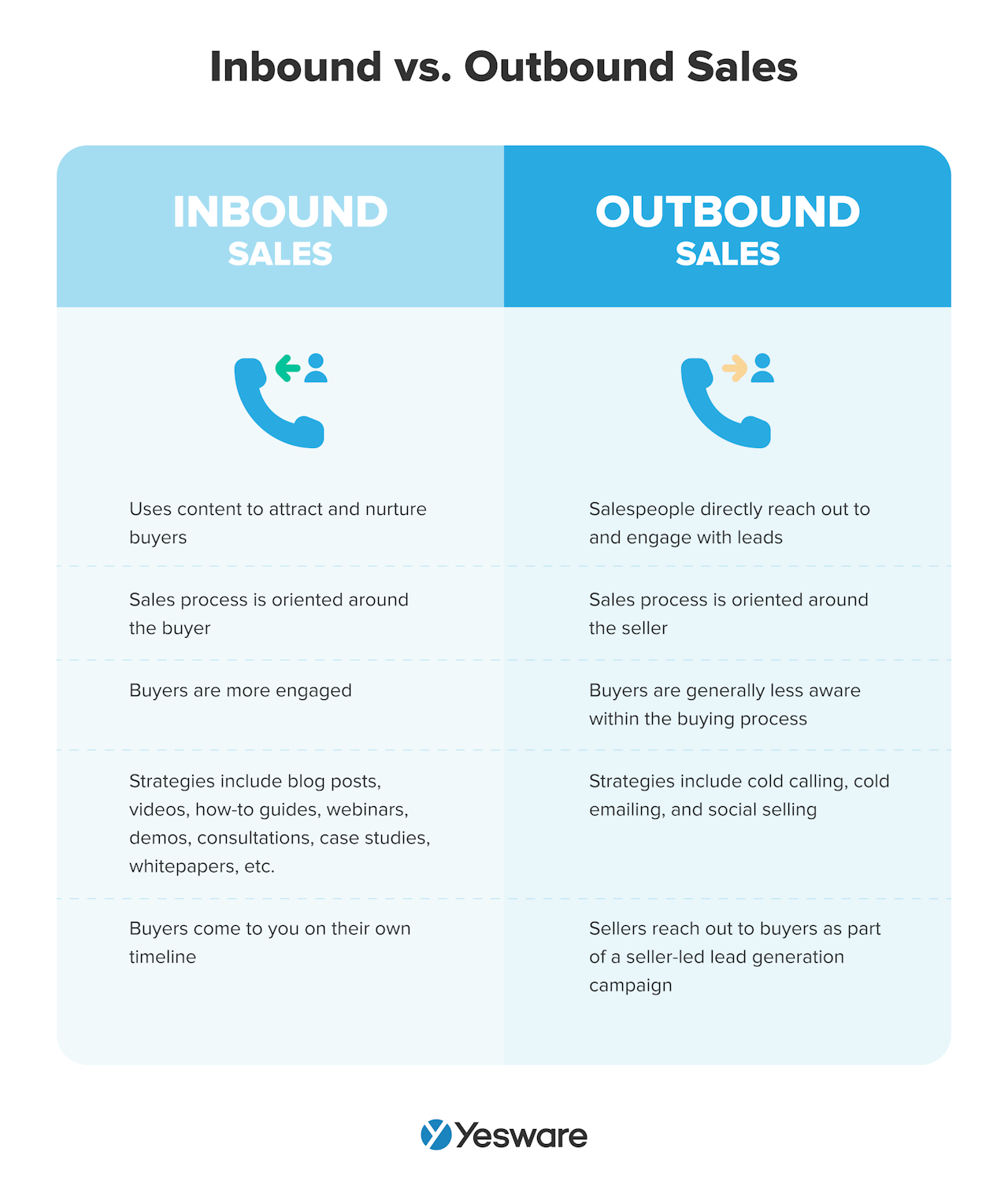 To be clear, both inbound and outbound selling have benefits in many B2B sales industries. In fact, most teams find that a hybrid approach works best for both their sellers and buyers.
To be clear, both inbound and outbound selling have benefits in many B2B sales industries. In fact, most teams find that a hybrid approach works best for both their sellers and buyers.
But today’s B2B buyer has a tremendous amount of control in the buying process — more than they ever have in the past. Most buyers now prefer to conduct much of their own research independently and will delay making contact with a sales rep until they feel properly armed with education, objections, and questions.
Inbound sales strategies give sales and marketing teams the opportunity to put themselves in front of buyers in a non-obtrusive way, with content that makes it easy for buyers to keep your brand top of mind as they educate themselves and deliberate when and how to make contact with the sales team.
More and more sales teams are finding ways to implement and optimize their inbound selling strategies, as the benefits are numerous and backed by data — over 60% of buyers respond to sellers who adopt these kinds of strategies. 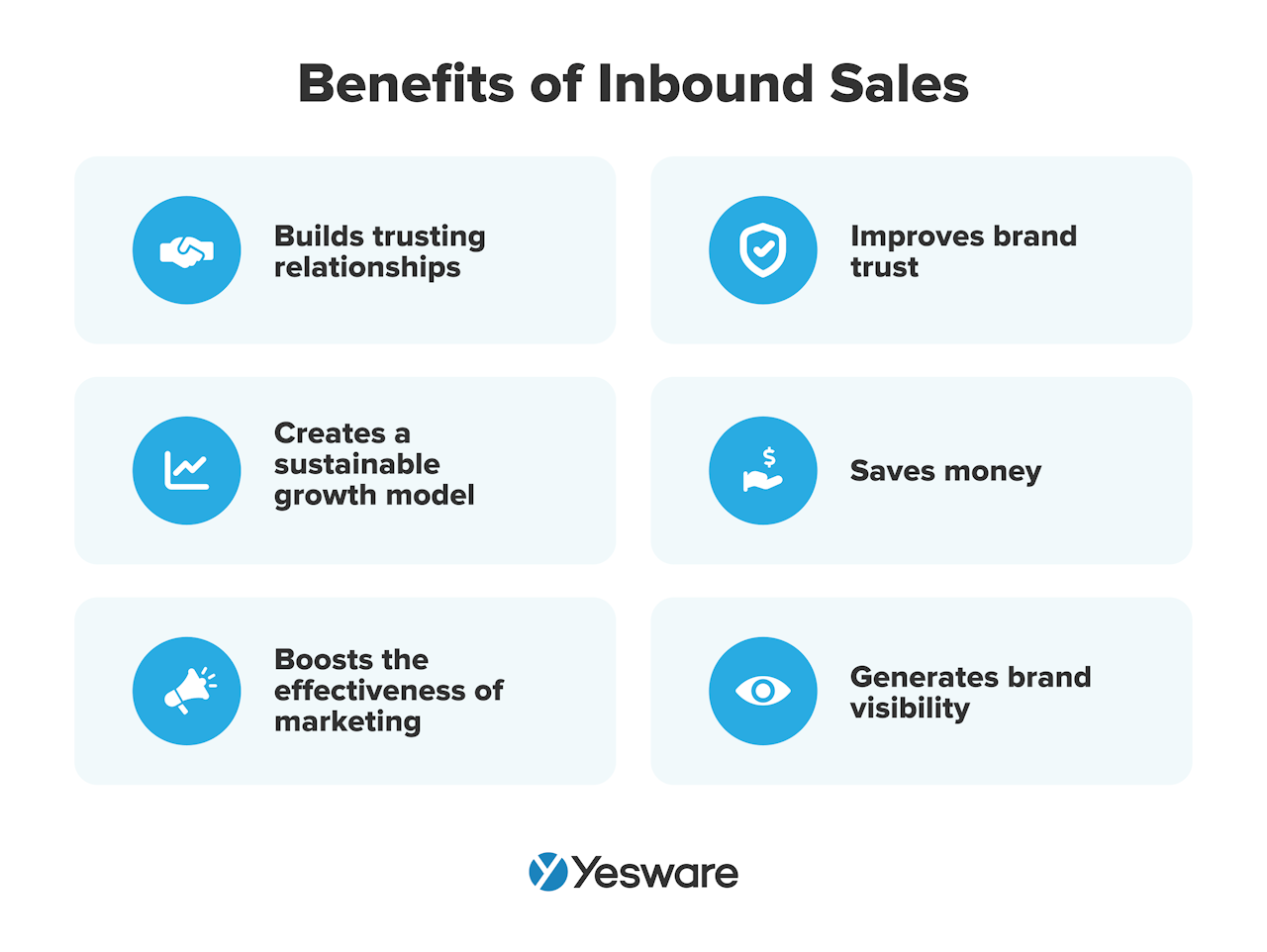
Target Account Selling
Target account selling (also sometimes called account-based selling or account-based marketing) is another highly personalized sales 101 approach that requires sales reps to dedicate most of their resources to just a few high-value, specifically targeted prospects.
In this sales approach, sales and marketing work together to build a list of highly qualified potential buyers; they then collaborate to create completely personalized campaigns built around the unique needs of each of these target accounts. Each decision-making team receives personalized support throughout the buying process and post-purchase.
Command of the Sale
Command of the Sale requires sales reps to have four main qualities: unmatched product and buyer knowledge, a knack for timing, and a certain je-ne-sais-quois that puts all eyes on them when they’re in a room. 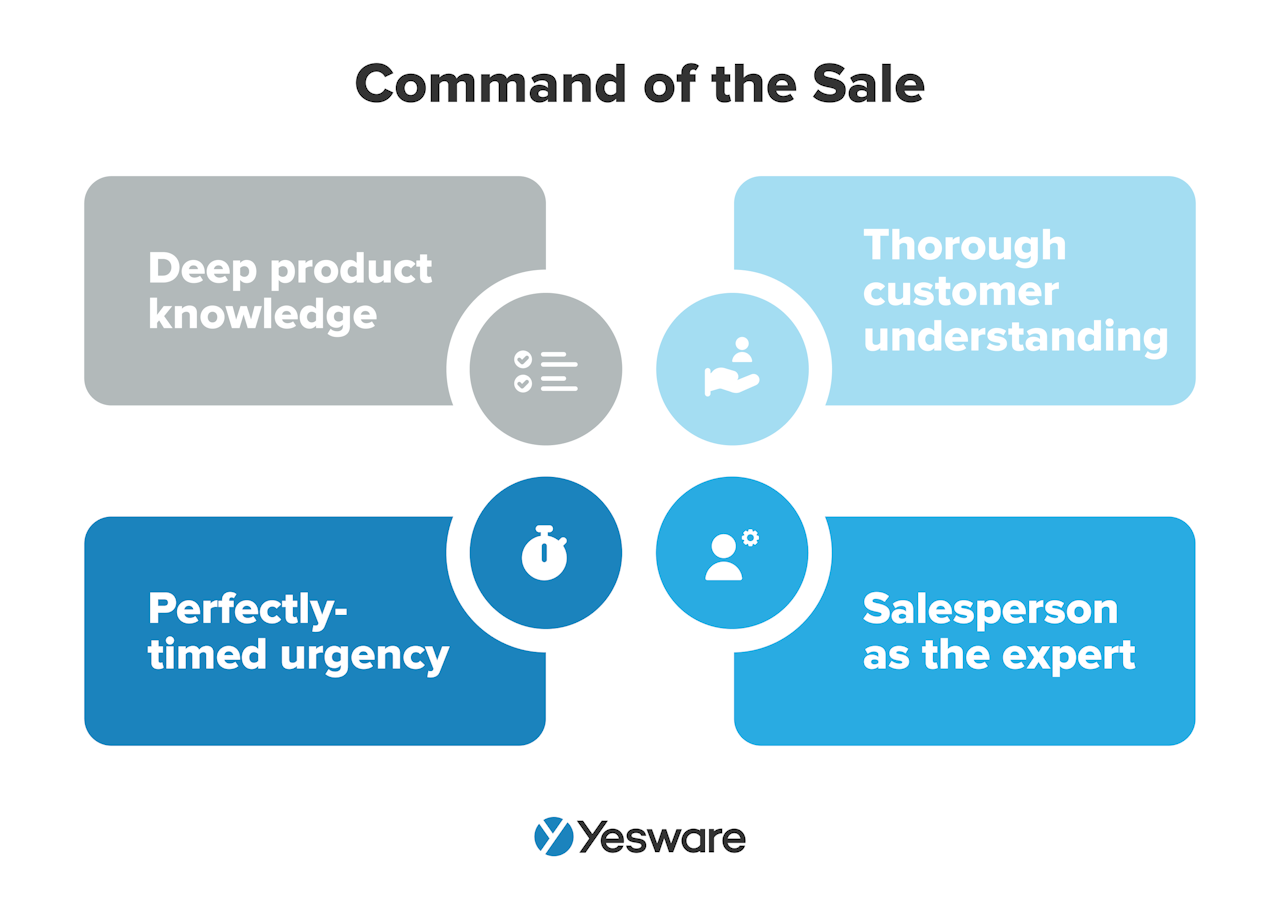 In some ways, a Command of the Sale approach encourages sales reps to be more like a “traditional” sales rep than most of the others on our list — a healthy dose of confidence is definitely required.
In some ways, a Command of the Sale approach encourages sales reps to be more like a “traditional” sales rep than most of the others on our list — a healthy dose of confidence is definitely required.
That being said, it’s a fine line to walk between confident and arrogant — and there’s nothing buyers dislike more than pushy reps. Be sure to put some time into training and coaching if you’re hoping to pursue this method.
Gap Selling
Gap Selling is about helping buyers identify the gap between where they are now, and where they ideally want to be in the future, and then positioning the offer as the ideal way to fill that gap. 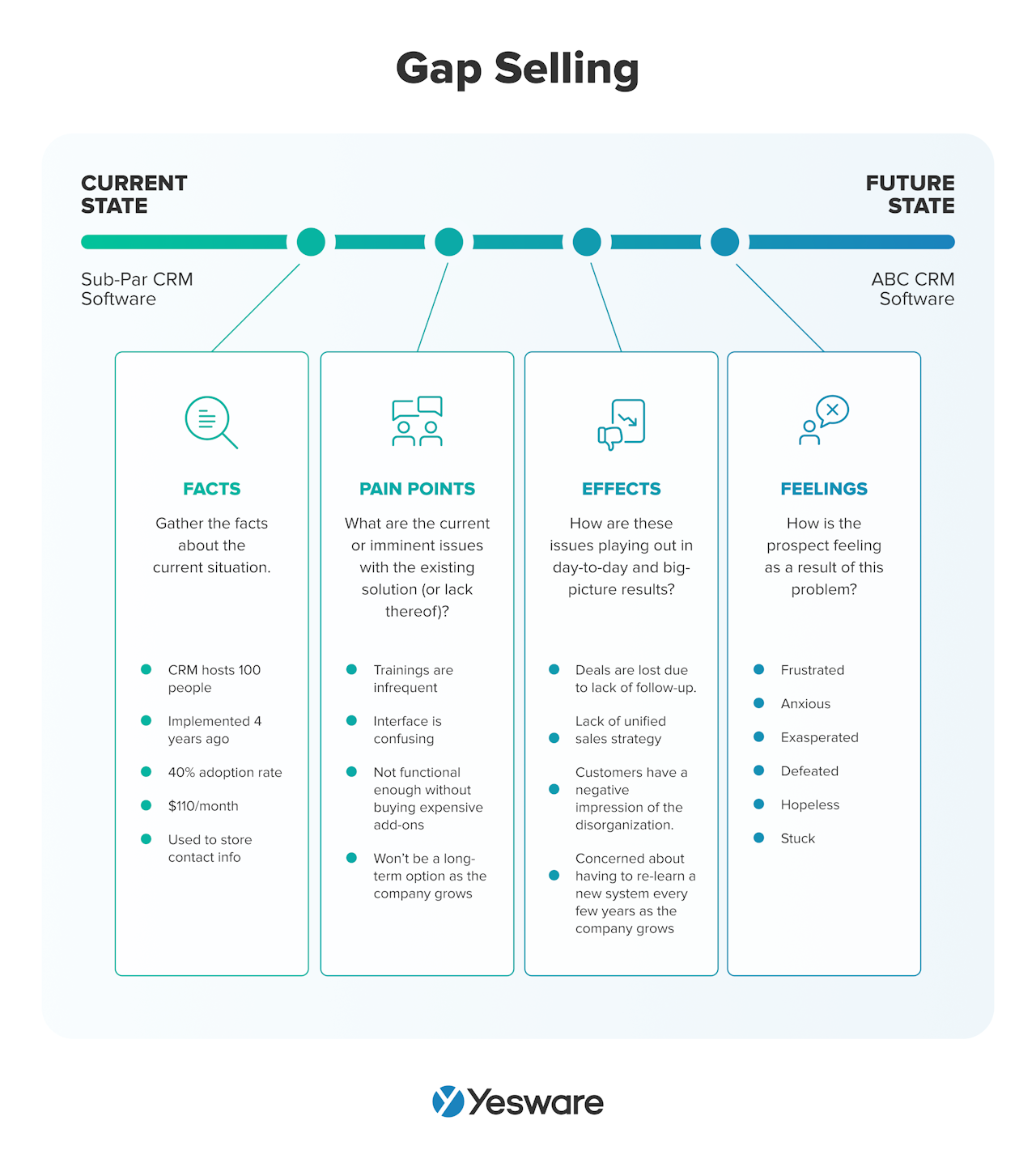 Inside the “gap” lives all of the prospect’s problems and pain points, and this is where sales reps spend most of their time in this approach.
Inside the “gap” lives all of the prospect’s problems and pain points, and this is where sales reps spend most of their time in this approach.
They need to quantify the gap as specifically as possible — how much is this issue costing them? Make the gap tangible. 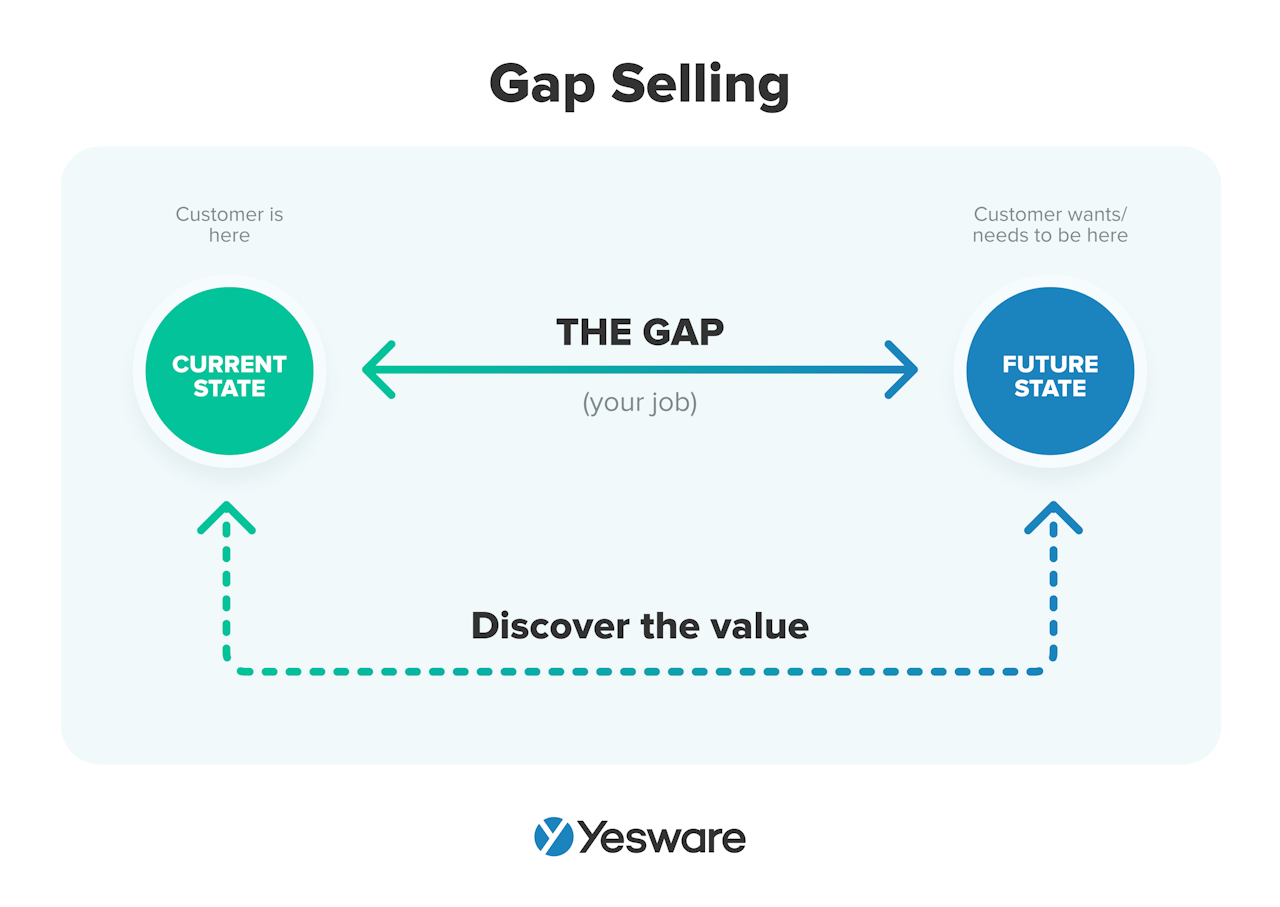 The wider the gap, the more motivated the buyer will be to solve their problem.
The wider the gap, the more motivated the buyer will be to solve their problem.
Tip: Looking for more sales techniques? Grab our data-backed ebook filled with the most successful ones.
 Sales Engagement Data Trends from 3+ Million Sales ActivitiesLooking at millions of tracked email activity over the past few years, this ebook is filled with our top studies and findings to help sales teams accelerate results.
Sales Engagement Data Trends from 3+ Million Sales ActivitiesLooking at millions of tracked email activity over the past few years, this ebook is filled with our top studies and findings to help sales teams accelerate results.
Effective Communication Skills
Even as recently as a decade ago, personalized communication with buyers was not a standardized approach. But today’s B2B buyer has no problem reserving their purchasing power for brands who make the effort to research their needs and approach them with personalized value.
What’s more, sales funnels today are longer than they have ever been — meaning your sales team needs to be “on” and delivering targeted, relevant content for a sustained period of time.
Buyer personas can be particularly helpful when it comes to systemizing your approach to personalizing the sales funnel.
It’s also important that sales reps have a solid grasp of all kinds of communication, as verbal, nonverbal, and written language all play an important role in the sales process.
It’s beneficial to keep the 7-38-55 rule in mind. This formula states that 55% of communication is achieved through body language, 38% through tone of voice, and 7% through spoken words. 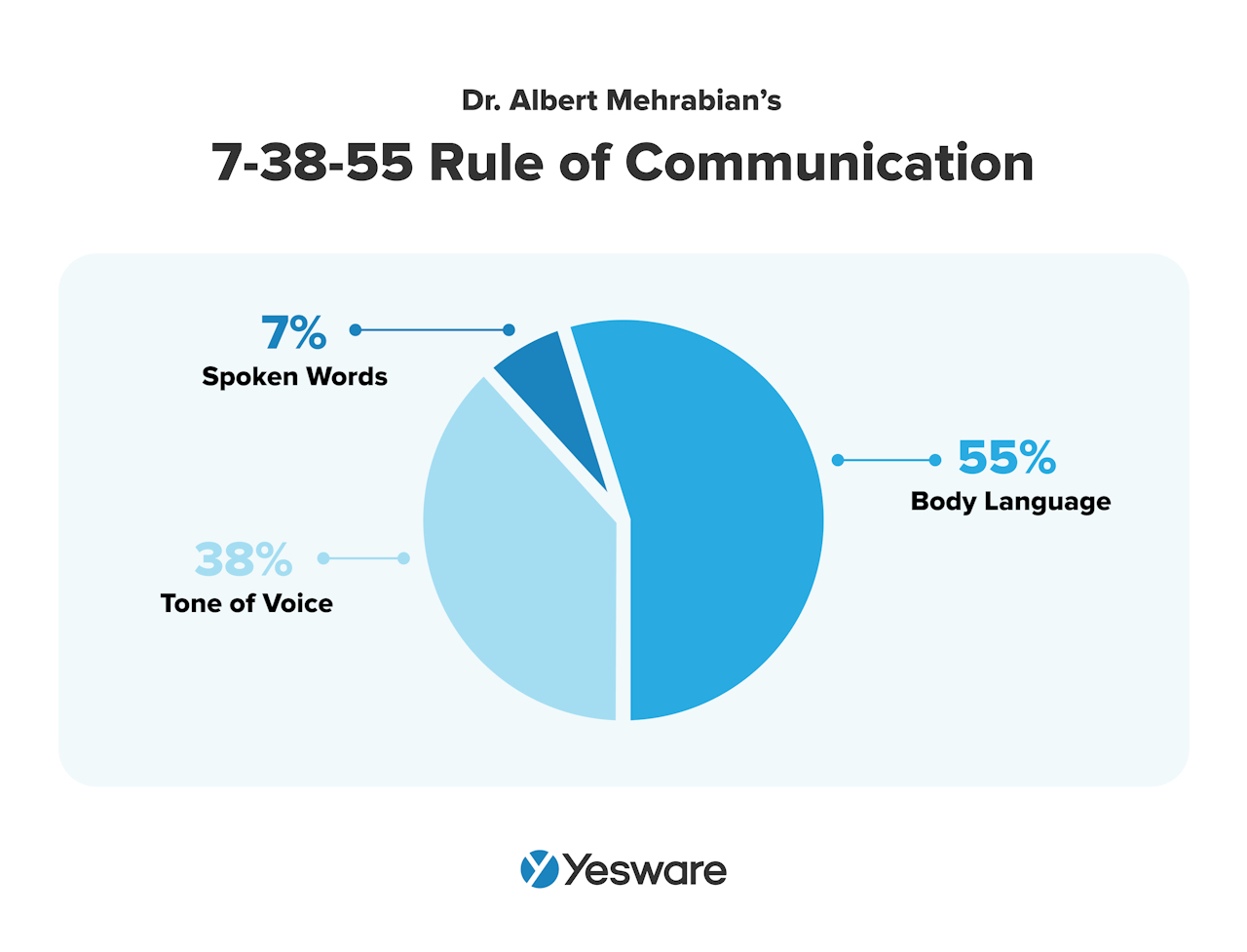 Aside from basic communication skills, sales reps also need to understand how to listen meaningfully and then pitch accordingly.
Aside from basic communication skills, sales reps also need to understand how to listen meaningfully and then pitch accordingly.
Active Listening
Thinking about communication in sales can be somewhat counterintuitive because the best B2B sales communicators actually do more listening than speaking.
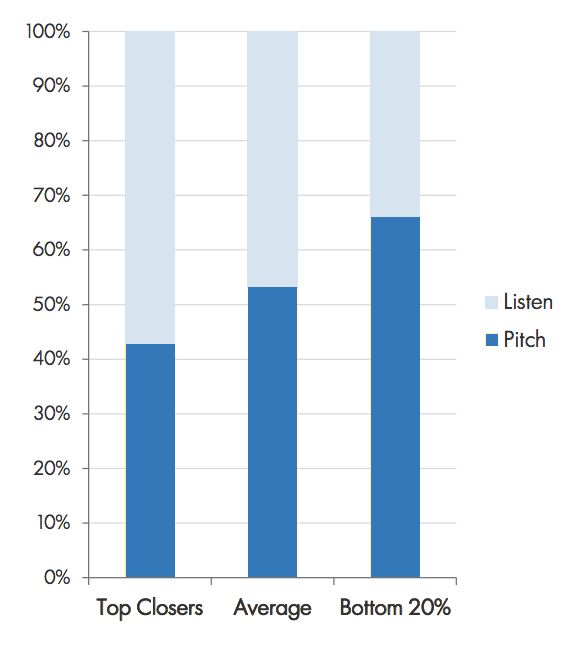
The more that sales reps can get their prospects talking, the more effectively they can tailor their sales pitch and craft their offer around the prospects’ unique and most pressing needs.
Active listening is one of the most effective tactics for sales reps to learn to help them understand the true messaging behind prospects’ words, tone, body language, and more. 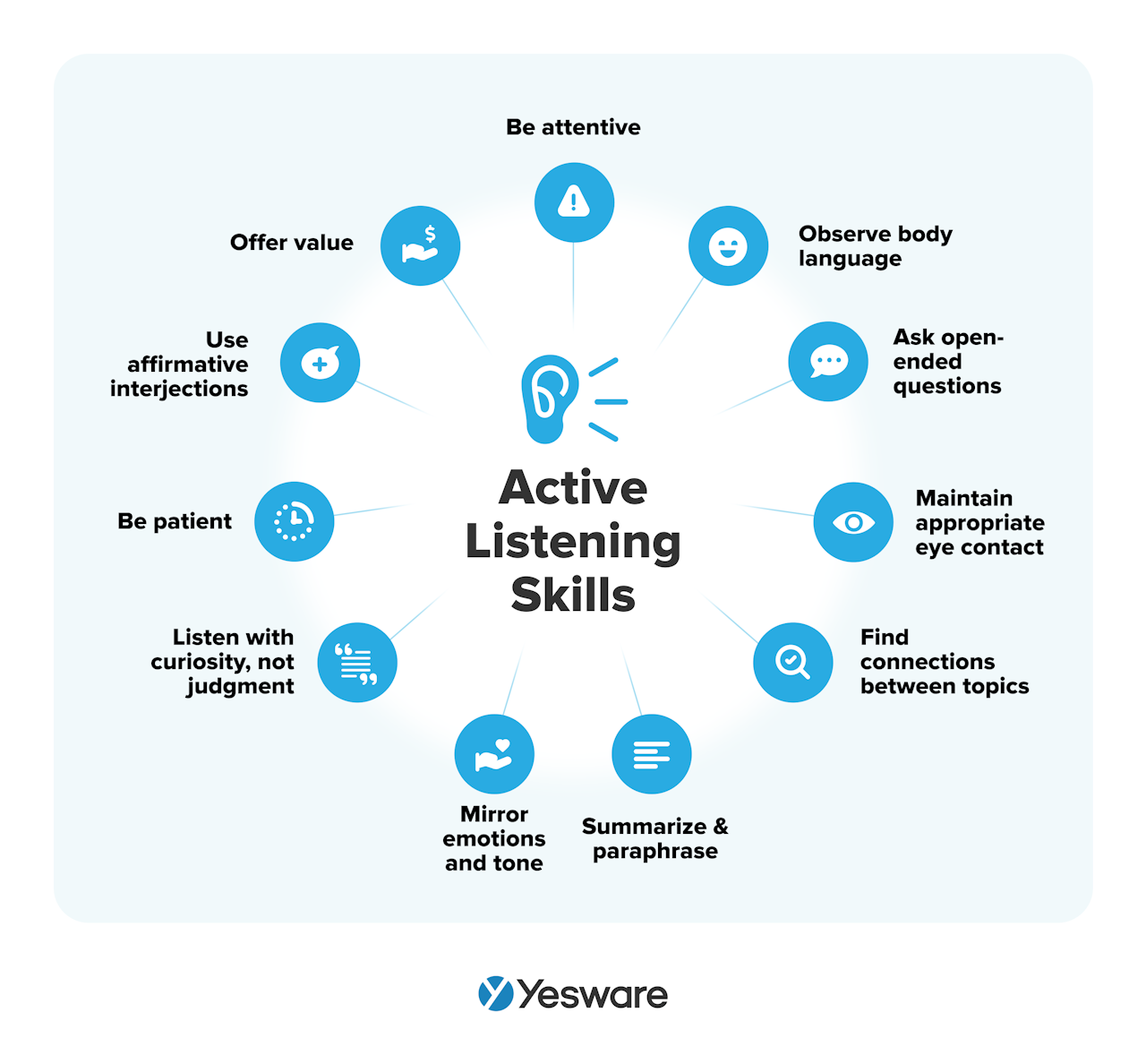
Sales Pitching
Sales pitching is another area that can feel a bit difficult to grasp, because the truth is that the majority of prospects have absolutely no desire to listen to a traditional sales pitch.
Today’s successful B2B sales pitch sounds more like a consulting meeting than a presentation. The key is to speak with the prospect, rather than at them, and try to engage with them at their level of expertise.
Keep the environment value-oriented and low-pressure, and show genuine interest in what they’re sharing. Try to get the prospect to say yes, or answer in the affirmative as often as possible.
Beyond that, just remember to keep your communication kind and honest; these characteristics are as important as any single remark, facial expression, or presentation tactic.
Tip: 15 Best Sales Pitch Examples.
Leverage Scripts and Email Templates
This next piece of Sales 101 advice is a bit nuanced, so consider it thoughtfully: sales scripts and email templates can be very helpful and even strategic when leveraged the right way.
The beauty of templates like cold call scripts and email frameworks is that they allow sales teams to track and measure the performance of their sales language.
And, as the saying goes, what gets measured gets managed; when you’re paying attention to how prospects respond to your most commonly used words, you can refine your messaging until it resonates perfectly.
In general, it’s important for sales reps to rehearse what they’re going to say in the first 30 seconds of their call. From there, it’s okay to go with the flow a little bit more — but there should still be a framework in place so that sales reps can guide the conversation as needed.
To access some of our most successful cold call scripts, check our two posts below:
Yesware also allows users to save and track their favorite email templates, so they can easily see which messages are opened and responded to the most frequently.
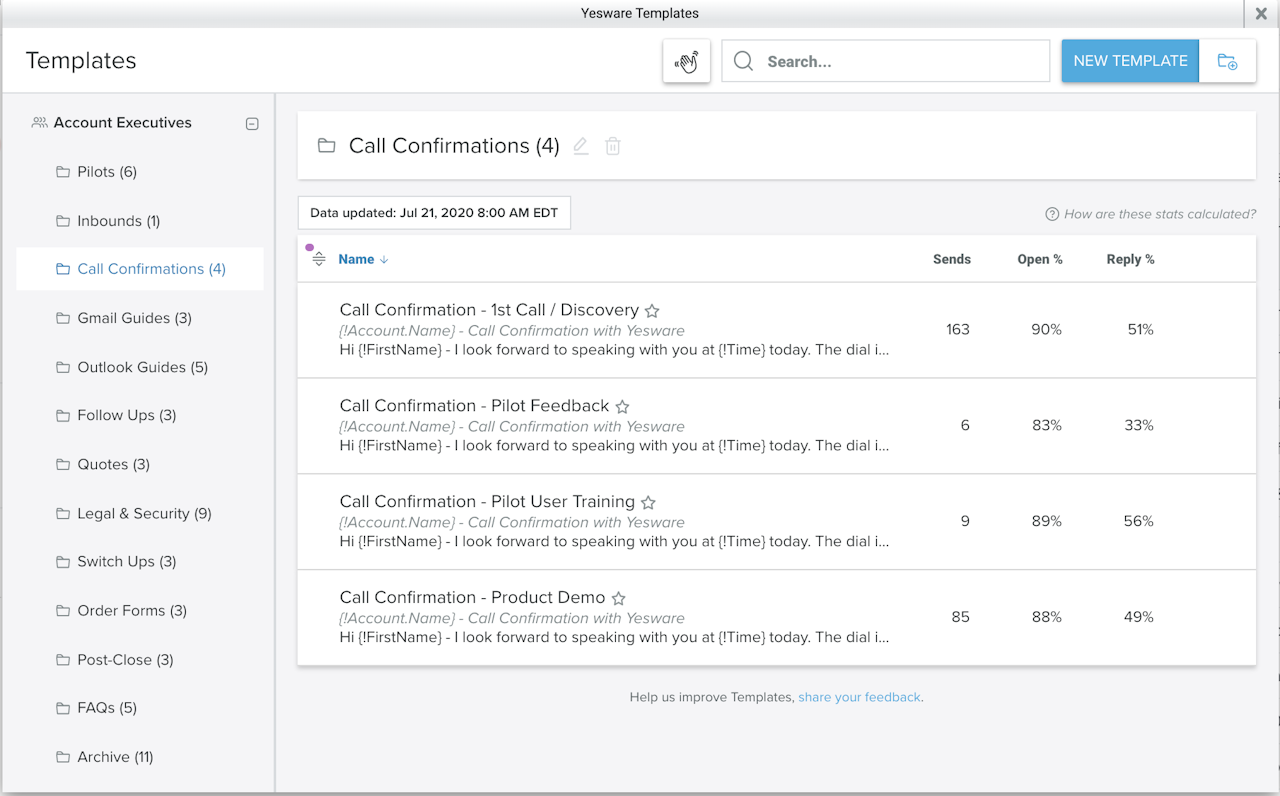
Be Curious and Ask the Right Questions
The most successful salespeople approach every sales opportunity with a sense of curiosity. The more you allow prospects to share their own experience, without sharing your own opinions or judgements, the better you’ll be able to curate the offer to satisfy their most pressing concerns.
One of the best ways to maintain an open mind throughout the sales process is by asking open-ended questions. 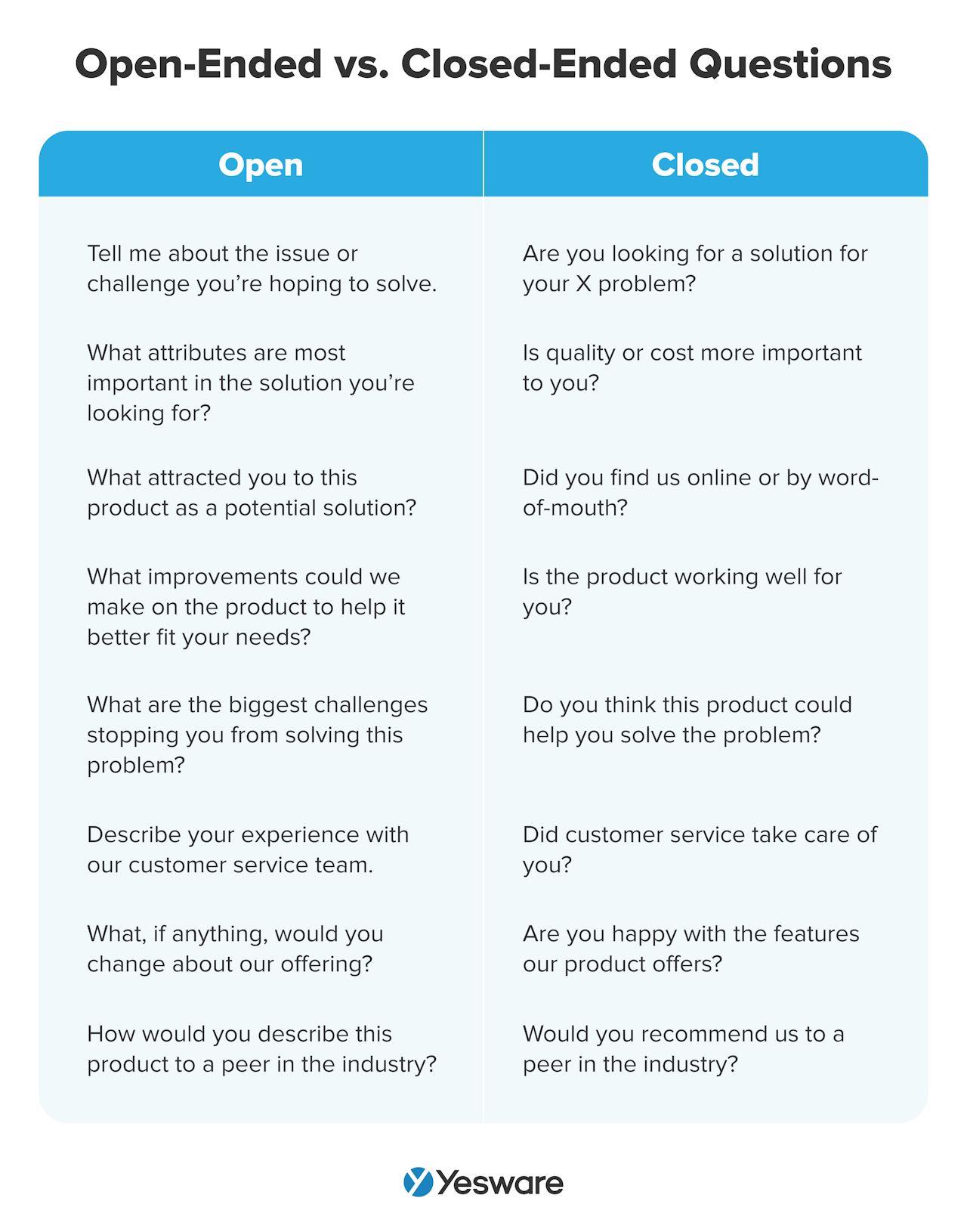 The more you can get the prospect to open up about their pain points, the better you can target your pitch later on in the sales process.
The more you can get the prospect to open up about their pain points, the better you can target your pitch later on in the sales process.
Overcoming Sales Objections
Whether sales reps like to admit it or not, sales objections are part of the job. 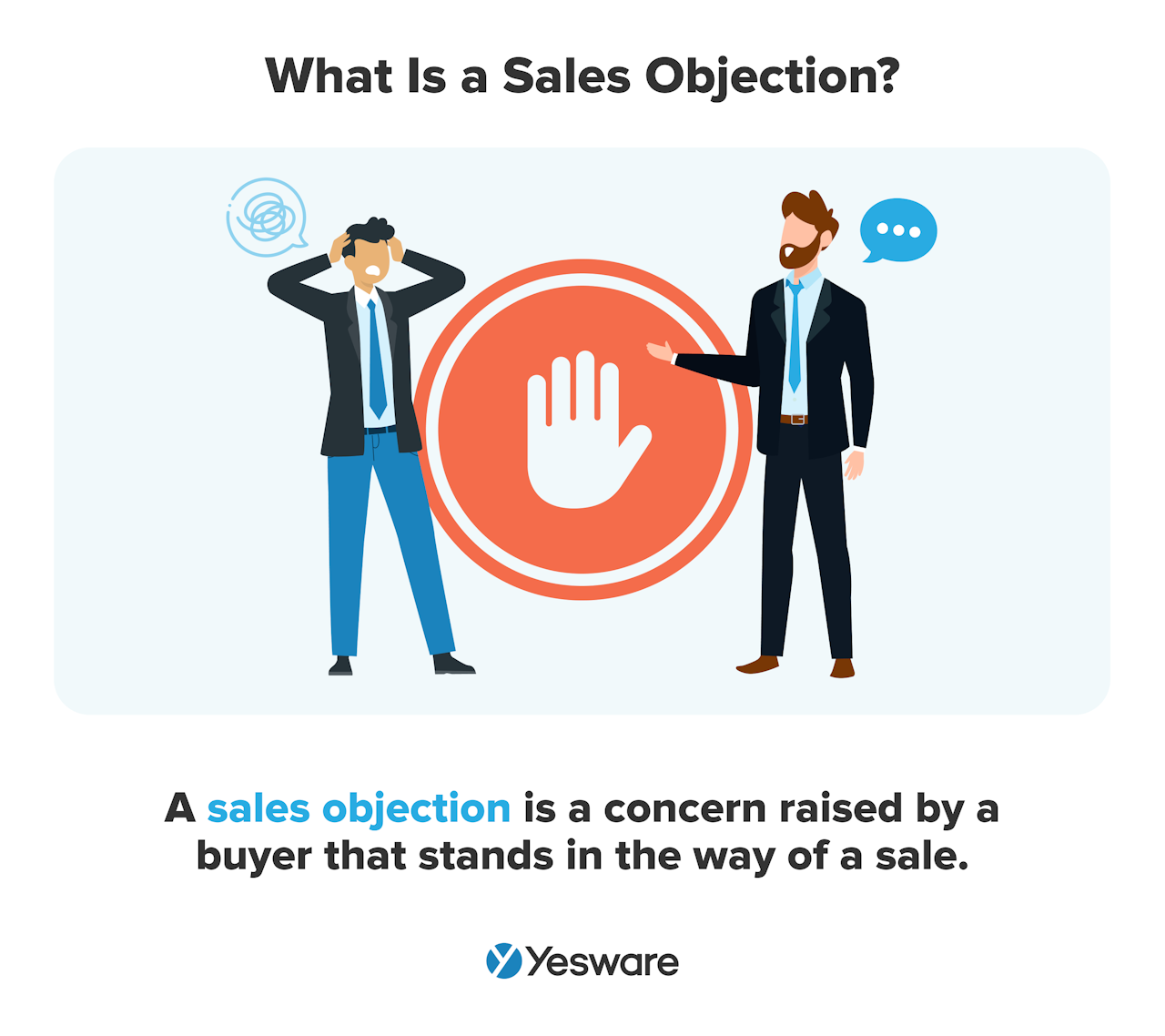 In fact, the best sales reps actually know how to use sales objections to their advantage.
In fact, the best sales reps actually know how to use sales objections to their advantage.
Most sales objections aren’t an outright rejection; they’re usually more of a hesitation that could potentially be assuaged with the right feedback. Great sales reps know how to use sales objections to learn more about a prospect’s needs and tout the benefits of their offer.
Fortunately, though there are virtually limitless “specific” sales objections, the vast majority of them fall into one of five main categories. 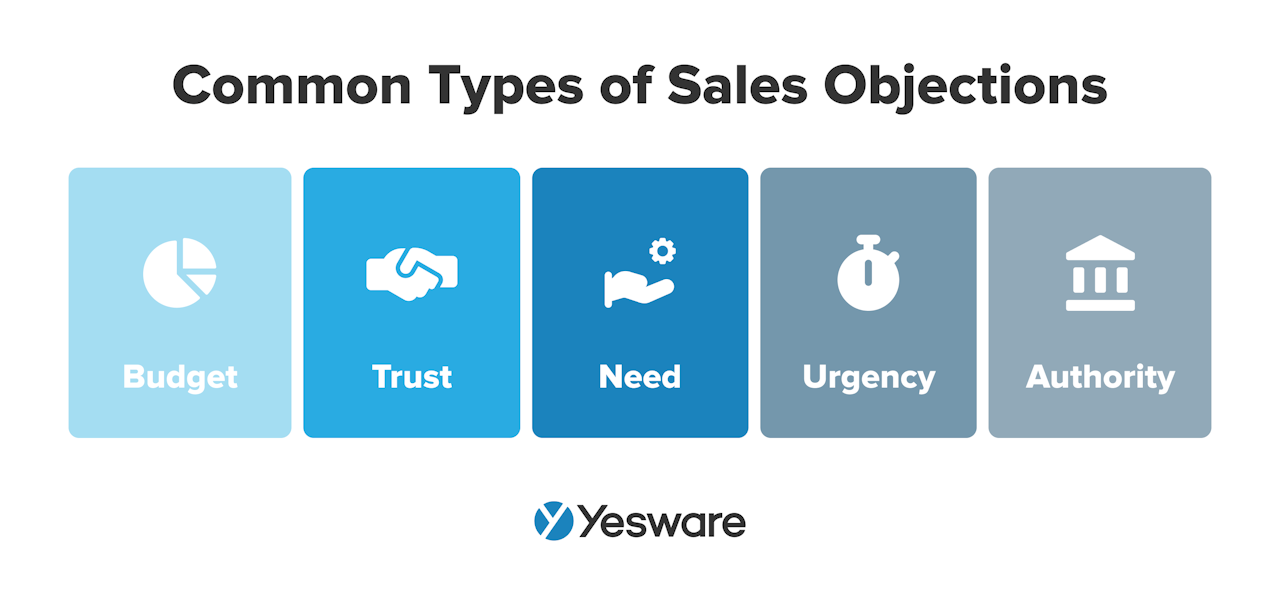 This makes it easier to rehearse responses to objections and navigate the interaction with care.
This makes it easier to rehearse responses to objections and navigate the interaction with care.
The key is to show the prospect that, regardless of the outcome of the sale, you are on their side. That means listening (without interrupting) and always avoiding defensiveness. 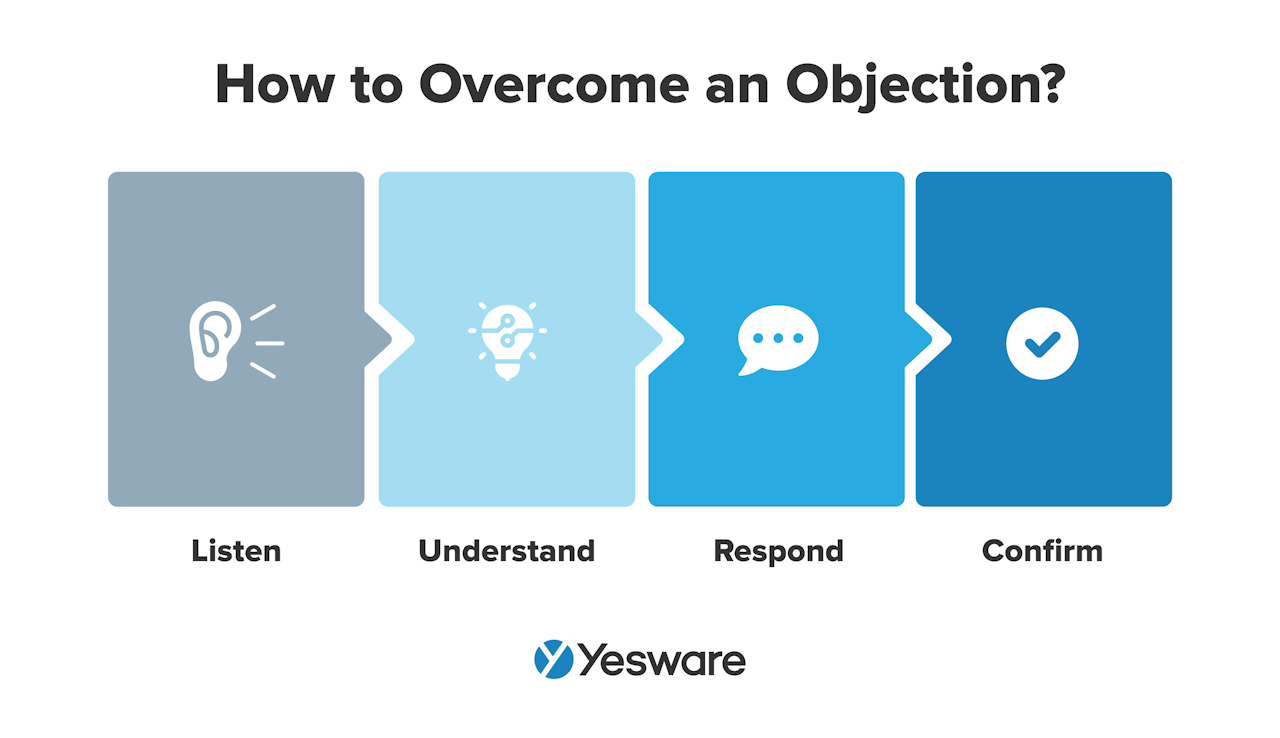 There’s also a strategy called “pre-framing” that can be very effective in preventing and/or navigating sales objections.
There’s also a strategy called “pre-framing” that can be very effective in preventing and/or navigating sales objections.
When sales reps pre-frame a sales meeting, they put parameters around how the conversation will proceed. This gives both parties structure and certainty and ensures that everyone is on the same page. Concrete next steps should also be made clear during the pre-frame.
When all else fails, a solid product demonstration is usually enough to stop most objections in their tracks (assuming, of course, that your product performs the way you promise!).
Sell Benefits, Not Features
Speaking of showing off your cool product features…that’s actually not necessarily best practice for Sales 101.
While it’s true that a live-action product demo can go a long way in backing up your claims (a picture’s worth a thousand words, after all, and a demo’s worth at least a thousand pictures), a written or spoken list of those same nifty features is a recipe for disaster within a sales conversation.
Instead, sales reps should focus on the benefits prospects stand to gain if they use the product, rather than the awesome technical specs. They can highlight the benefits that will matter most to each individual prospect by learning more about each of their unique pain points. 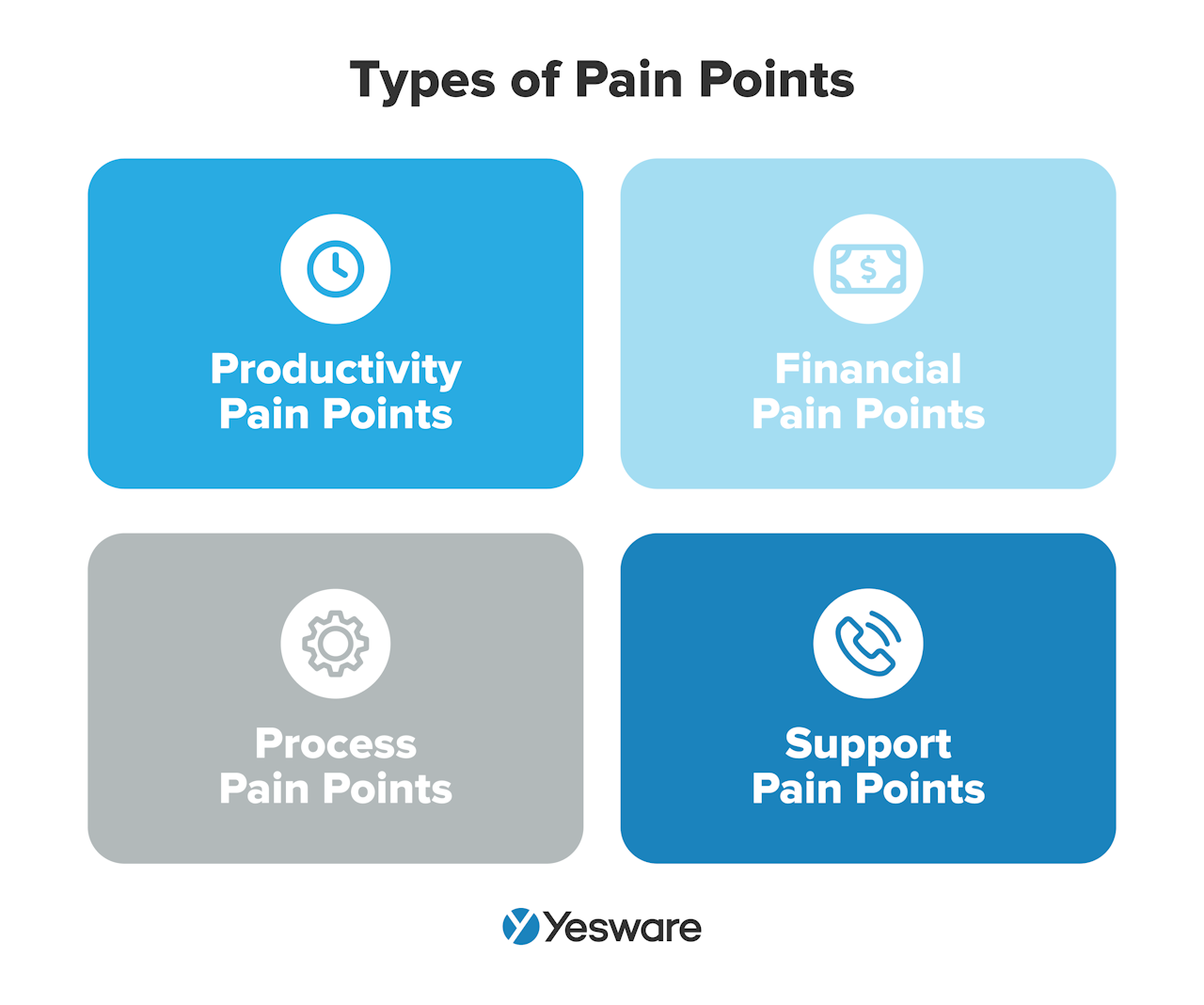 Your sales pitch should be different each time you deliver it, even if you only sell one type of product. Each sales cycle will take a different shape depending on the most pressing pain points of the prospect in the funnel.
Your sales pitch should be different each time you deliver it, even if you only sell one type of product. Each sales cycle will take a different shape depending on the most pressing pain points of the prospect in the funnel.
Follow Up
The follow-up is as important (if not more) than the first impression in B2B sales. In fact, over 80% of sales require four or more follow-ups before the prospect agrees to proceed. Unfortunately, most sales reps give up far sooner. 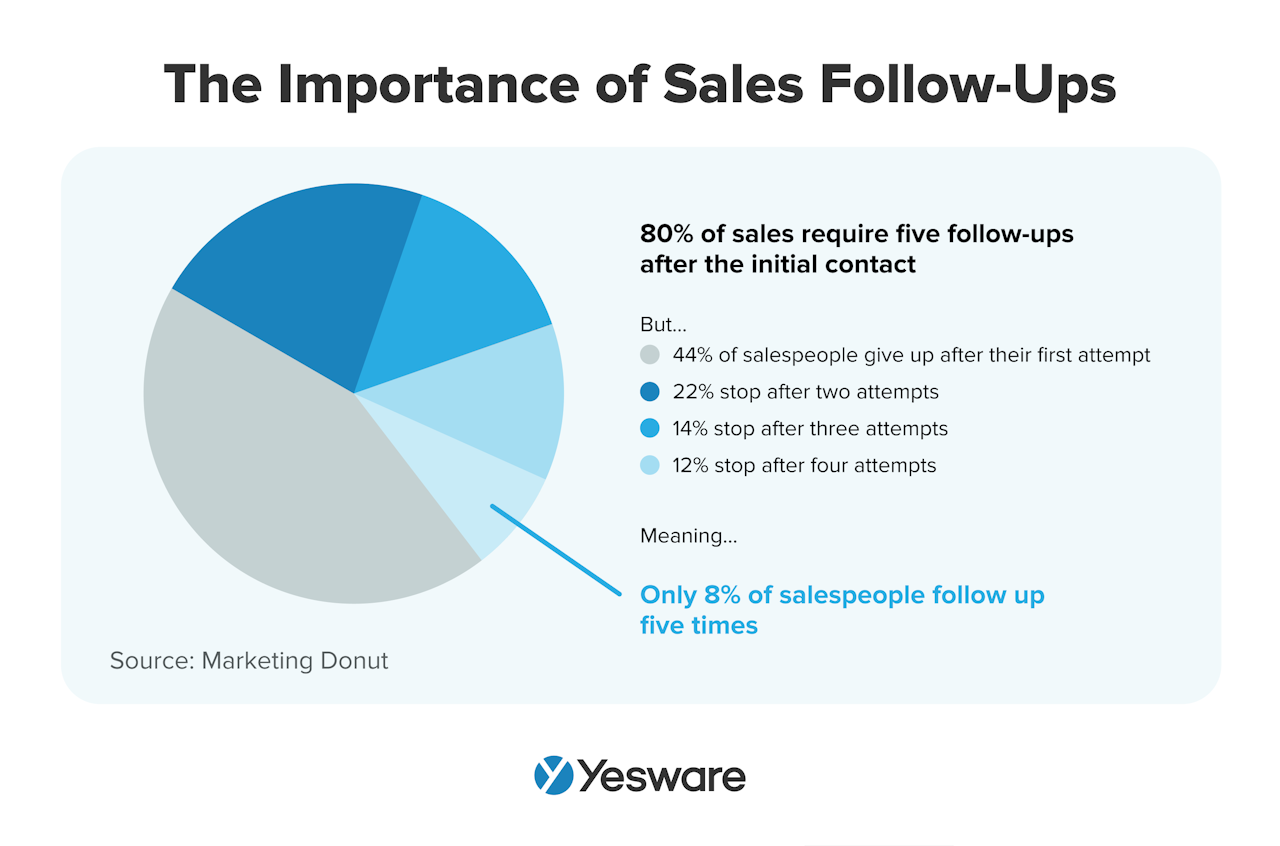 Mastering the follow-up is one of the hallmarks of Sales 101. Salespeople who can learn how and when to follow up effectively will see significant impacts on their conversion rate.
Mastering the follow-up is one of the hallmarks of Sales 101. Salespeople who can learn how and when to follow up effectively will see significant impacts on their conversion rate.
A good rule of thumb is to ensure that every interaction concludes with both parties agreeing to tangible next steps. This might mean scheduling a meeting, a phone call, or even a week’s pause to reflect on the offer — the key is to pin down together what to expect in the follow-up.
Sales reps can also use data to give them a boost when it comes to sending follow-ups when they’re most likely to get noticed.
According to Yesware’s best time to send email data, the best time is 1pm, followed closely by 10am. These are the times when email readers are most likely to send a reply. 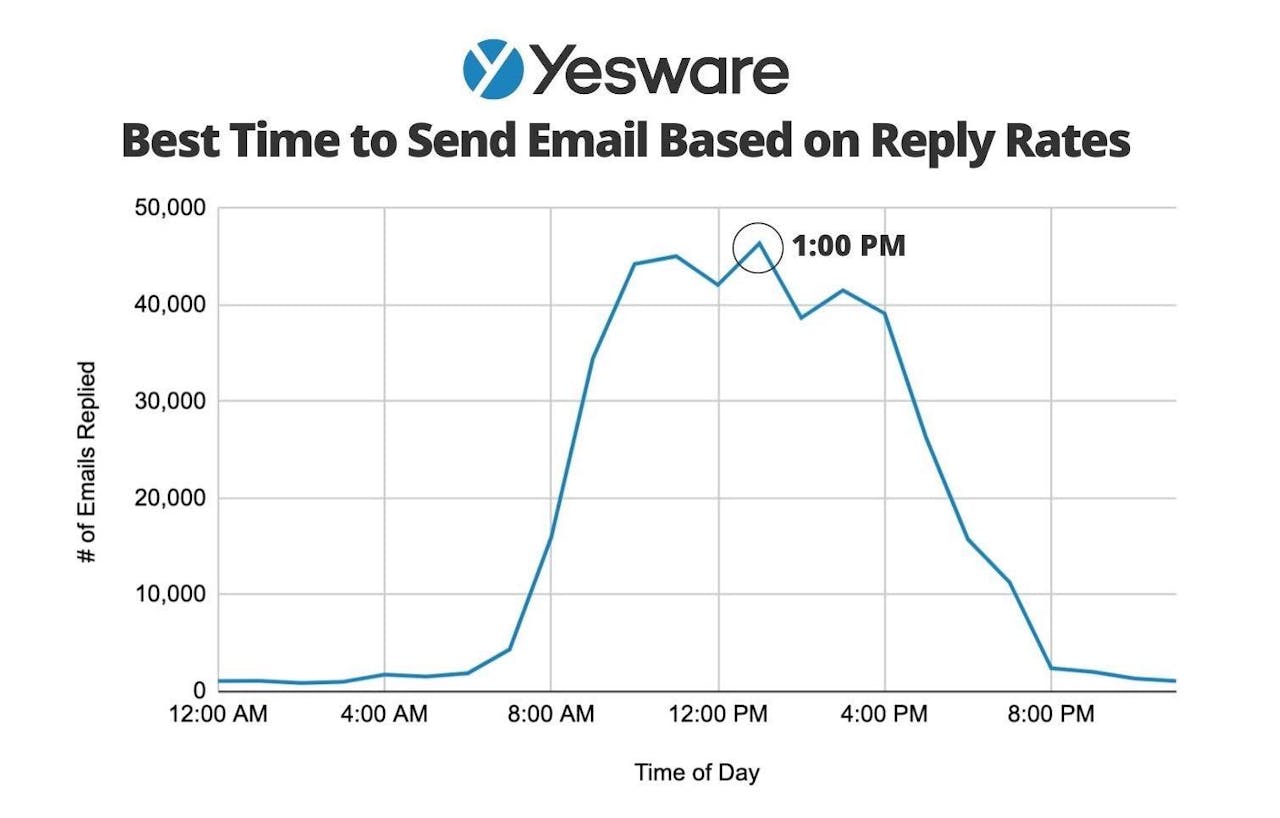 To learn more about how to follow up in a way that progresses prospects down the funnel, click here.
To learn more about how to follow up in a way that progresses prospects down the funnel, click here.
Close the Sale
Closing the sale is one area where many sales reps don’t feel comfortable, regardless of how well they navigate the rest of the sales process.
Closing sales does require a distinct set of skills and careful attention to buyer (verbal and non-verbal) communication. Sales reps need to know how to look for and interpret buying signals that indicate readiness to purchase.
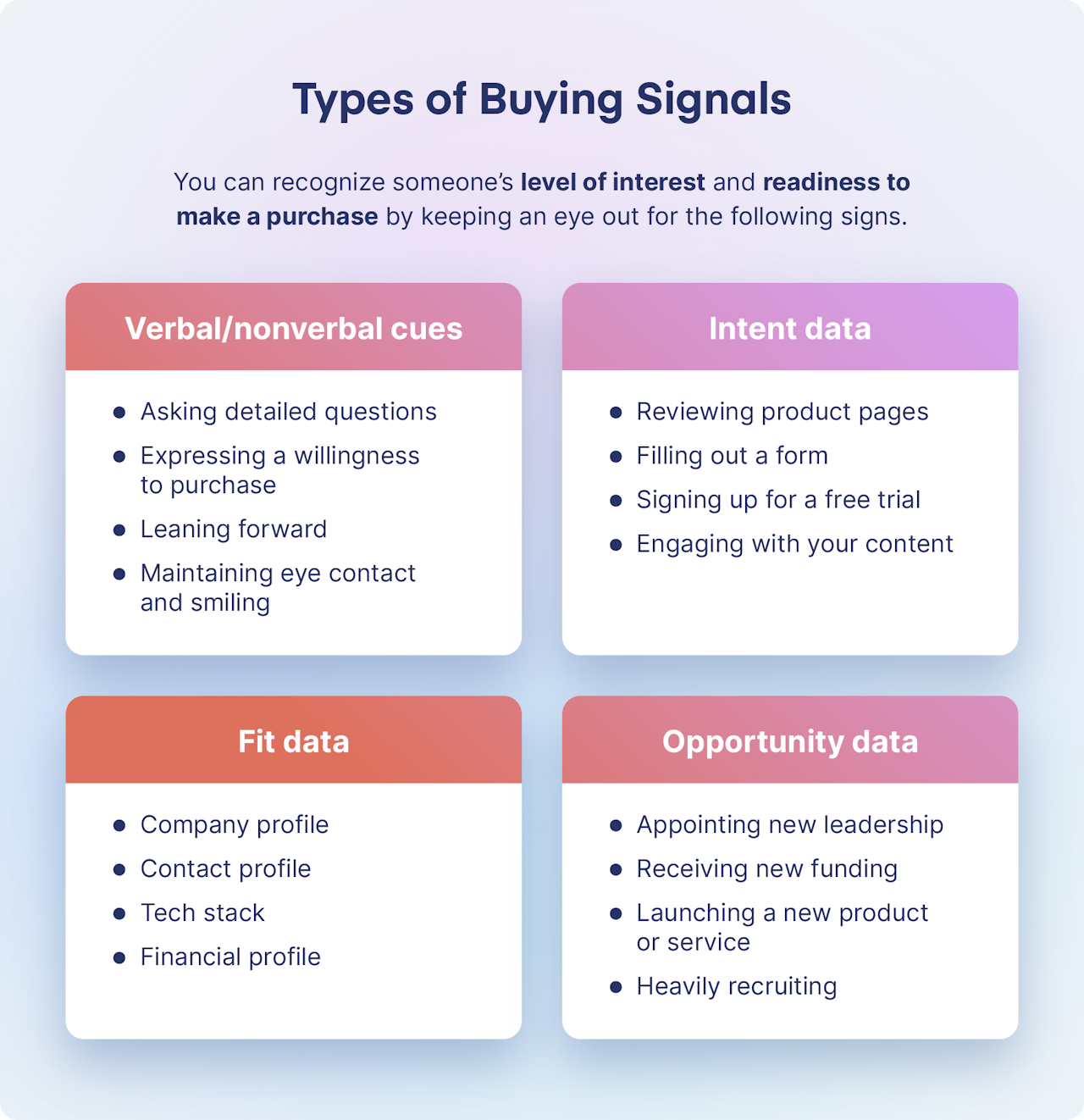
There are additional subtle indicators, like speeding up the sales cycle, asking specific questions about pricing, and replying to your outreach more quickly, that also suggest a buyer is eager to close.
Direct Close
For those buyers who indicate readiness to buy, a direct close might be appropriate. This is a strategy in which sales reps ask very directly whether the buyer is ready to sign a contract and close the deal.
They might say something like, “How many months would you like your contract to run, 24 or 60?” or, “I’ll send the contract over by COB today.”
Indirect Close
Indirect closing, on the other hand, is a bit more subtle. This tactic is more often used with buyers who are a bit less outwardly committed, but who likely could be guided to close with the right prompting.
Questions like, “How does that sound?” and, “What are your thoughts on that timeline?” can help reps gauge a prospect’s readiness a bit more clearly.
Another closing tactic that’s effective for many sales reps is adding a sense of urgency to the close. Some reps do this by offering limited-time discounts or promotions that encourage the prospect to sign quickly, while others craft a careful opportunity cost message that outlines what the prospect stands to lose or suffer by not purchasing today.
Regardless of the specific closing strategies that work best for your target market, remember that the B2B sales cycle is long, especially in the SaaS market. By the time all parties are getting ready to close the deal, much has already been discussed and debated. With that in mind, it’s a good idea to include a summary in your closing process so that everyone is on the same page about how the deal is moving forward.
Nurturing Customer Relationships
Although this topic may not be covered in some traditional “Sales 101” playbooks, we believe at Yesware that post-sale customer relationships are one of the most important factors to success in this field.
Remember that buyers today expect — require, even — high levels of personalization throughout the sales process. And while many reps are willing and able to provide that during the sales cycle, some mistakenly withdraw those efforts once the prospect signs a contract.
This, in turn, leaves a lot of customers wondering how genuine the connection was in the first place.
As a general rule of thumb, it’s a good idea for sales reps to follow up with signed customers after one week, one month, every quarter, and a year after signing their contract.
Keep in mind that some customers will expect more than this, while others may indicate a need for less contact — it’s important to “read the room” and use your discretion here.
Regardless of contact frequency, the sales rep is always responsible for a seamless handoff to the onboarding process and/or customer success team.
The Benefits
Post-sale customer relationship management isn’t just important for your reputation as an authentic salesperson; it can also have a dramatic impact on your bottom line. Which is why it’s an important Sales 101 tactic to keep in mind.
Sales reps who stay in touch with customers after the first sale often find accounts that are ripe with opportunities for cross-selling and upselling. 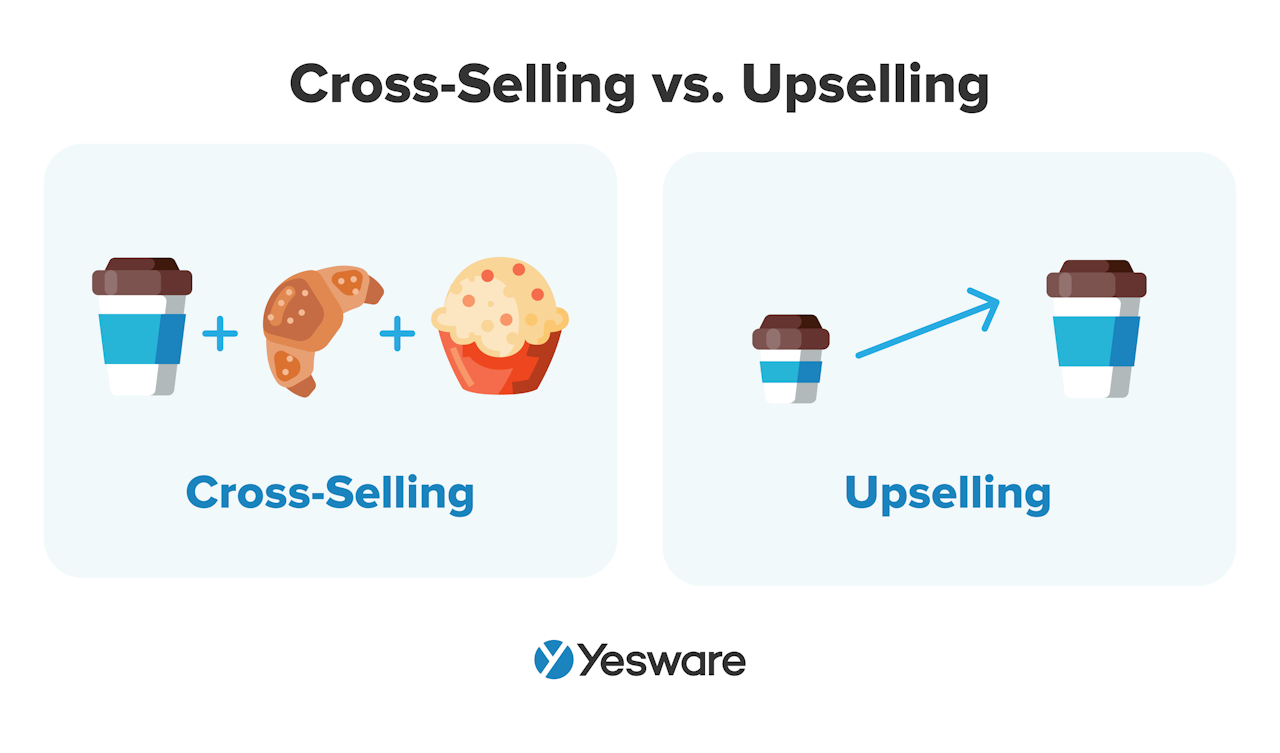 These opportunities are low-hanging (and highly lucrative!) fruit:
These opportunities are low-hanging (and highly lucrative!) fruit:
- It can cost up to 5x more money to acquire a new customer than to retain an existing one
- Increasing customer retention by just 5% can increase profitability by 25% – 90%
- The success rate of selling to an existing customer is 60% – 70%, while the general success rate for signing new customers is much lower (5% – 20%, depending on your industry)
Happy customers also represent a great opportunity for a robust referral program, which can be like gold for sales teams and overall revenue stream. 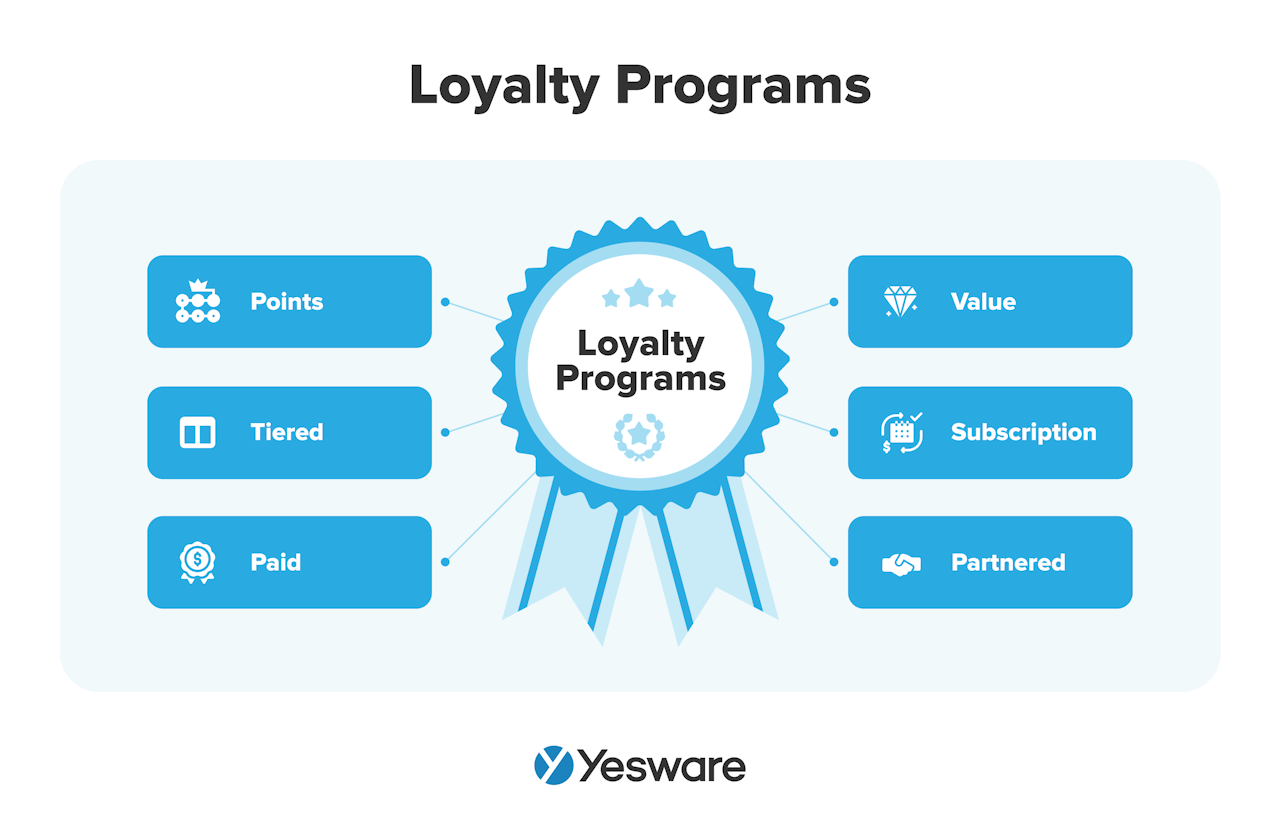
Analyzing Sales Data for Improvement
It’s been said before, but it’s worth repeating: what gets measured gets managed, and that is acutely accurate in sales.
Sales teams need to have standardized processes in place for collecting, storing, and analyzing their sales data. This adds crucial data to all decision-making processes.
All sales teams will have a different set of sales metrics and key performance indicators (sales KPIs) that matter most to their sales goals and bottom line. In fact, some teams may even shift their focus from quarter to quarter. 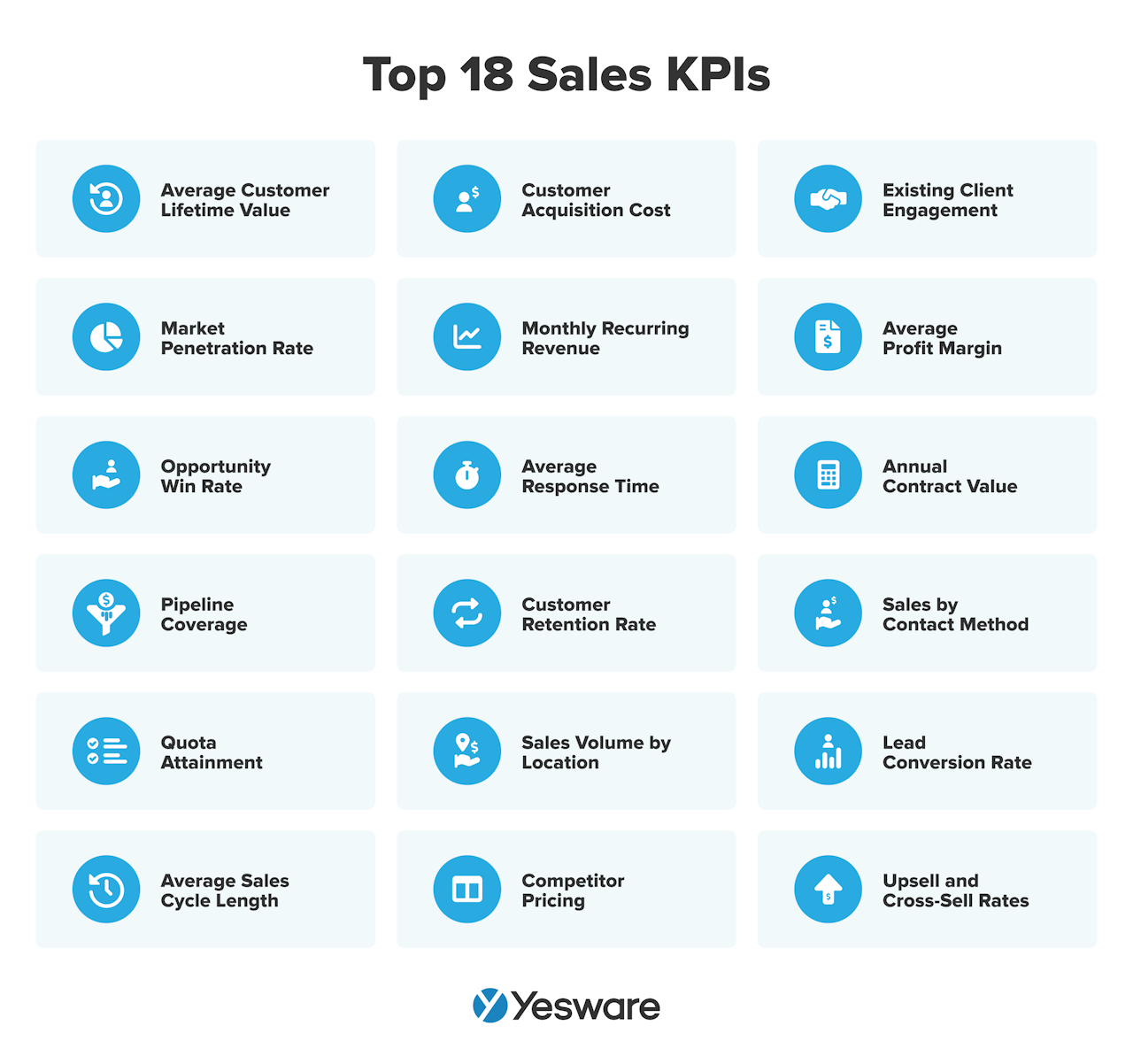 What matters, though, is that there are processes in place for looking at the data, and analyzing it in a way that generates actionable, growth-oriented insights. The reason sales teams study sales metrics and KPIs is to create opportunities for continuous improvement.
What matters, though, is that there are processes in place for looking at the data, and analyzing it in a way that generates actionable, growth-oriented insights. The reason sales teams study sales metrics and KPIs is to create opportunities for continuous improvement.
Staying Adaptable in a Dynamic Market
Now more than ever, sales is an industry that shifts and changes quickly. Everything from the market landscape to competitor challenges to buyer preferences can change on a dime.
And while many sales reps crave this kind of fast-paced, think-on-your-feet environment, it can also present a challenge for those who aren’t proactive about their mindset.
Attitude matters in sales more than more people consciously realize. A growth mindset — one that views challenges and mistakes as opportunities to learn, rather than failure — can go a very long way in improving all of your sales skills and techniques. 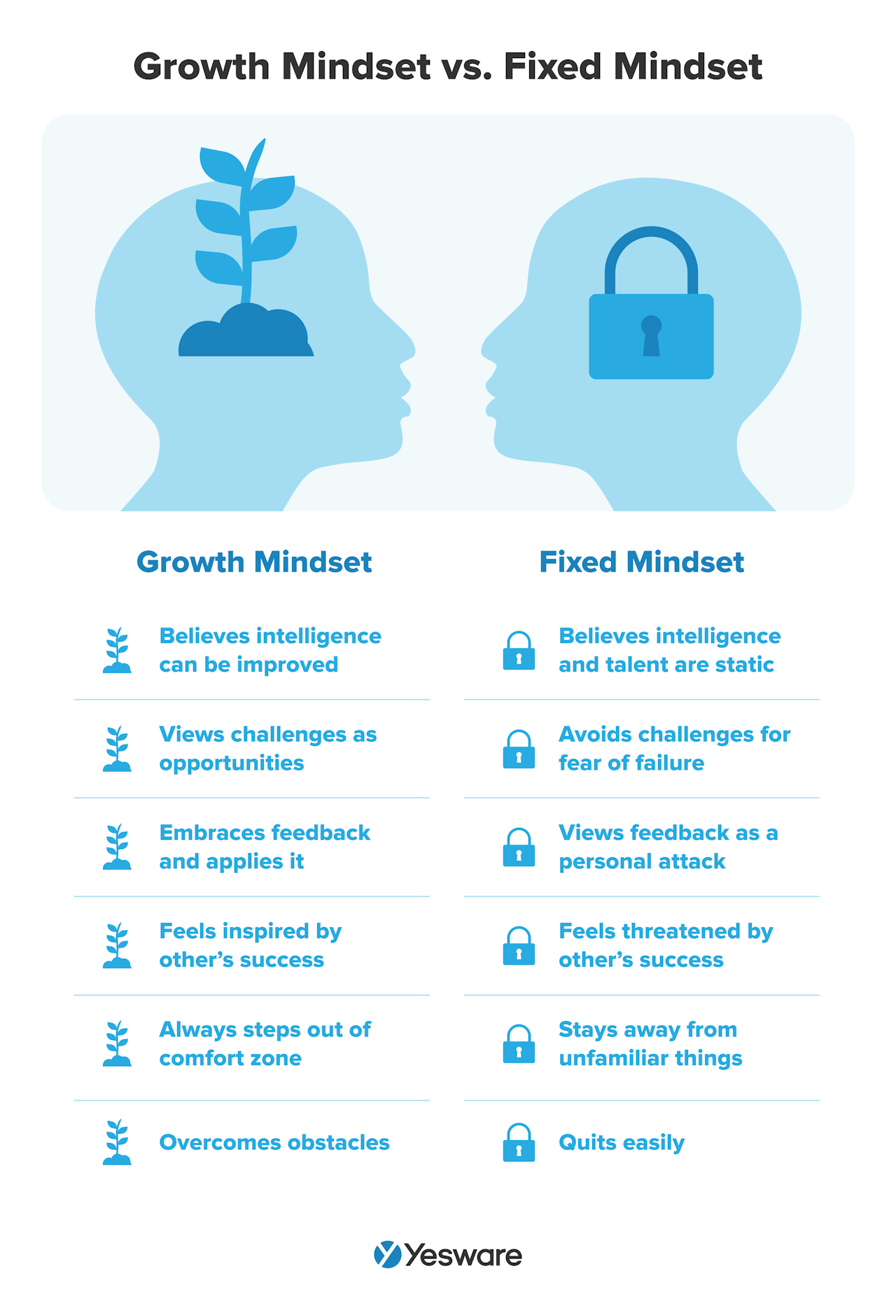 Consistency and presence matter a lot in sales, especially when you’re still learning the ropes of Sales 101. If you show up with positivity, invest in yourself, and track and refine your progress, you will see significant growth over the course of your sales career.
Consistency and presence matter a lot in sales, especially when you’re still learning the ropes of Sales 101. If you show up with positivity, invest in yourself, and track and refine your progress, you will see significant growth over the course of your sales career.
Conclusion
As you can see from this article, sales is not a simple or slow-paced career.
The more the sales reps can master the basics of Sales 101, the more they will generate opportunities for career growth and advancement. When sales teams have a solid grasp of the fundamentals of Sales 101, they can dedicate more of their efforts to maintaining the kinds of relationships that long-term SaaS contracts require.
A readiness to learn and a willingness to try new things will go a long way in achieving success in Sales 101.
Is there anything you would add to our Sales 101 list? What strategies or tactics helped you the most when you started your sales career?
More Guides for Sales Success:
Get sales tips and strategies delivered straight to your inbox.
Yesware will help you generate more sales right from your inbox. Try our Outlook add-on or Gmail Chrome extension for free, forever!
Related Articles
Casey O'Connor
Casey O'Connor
Casey O'Connor
Sales, deal management, and communication tips for your inbox

